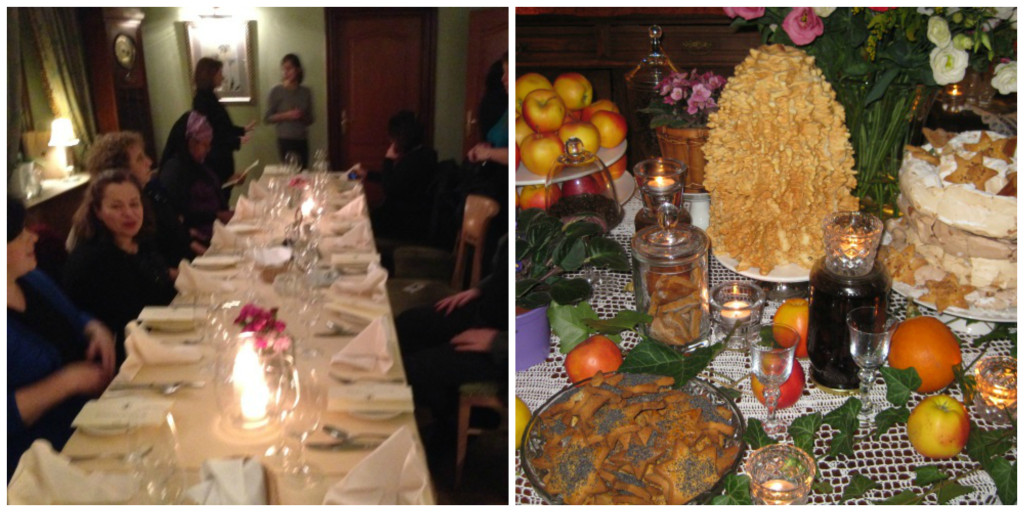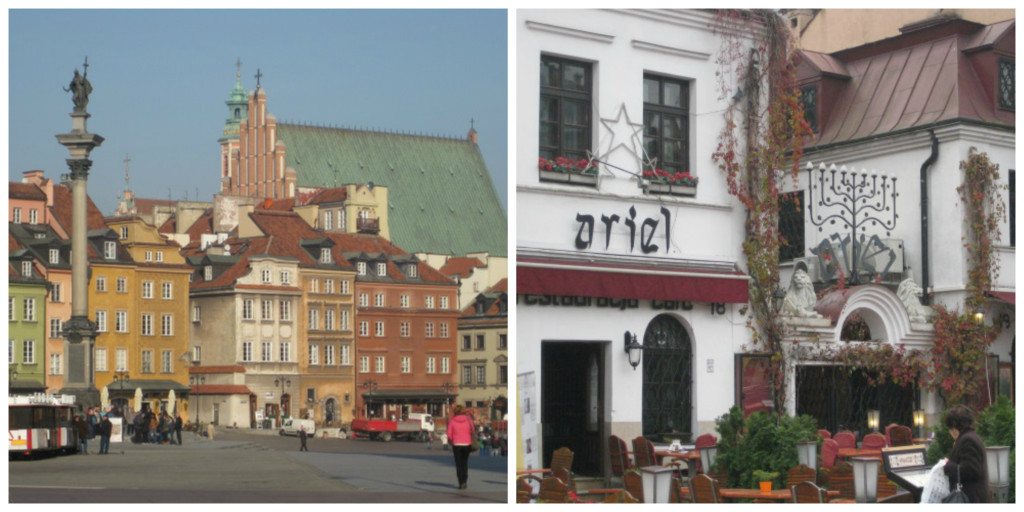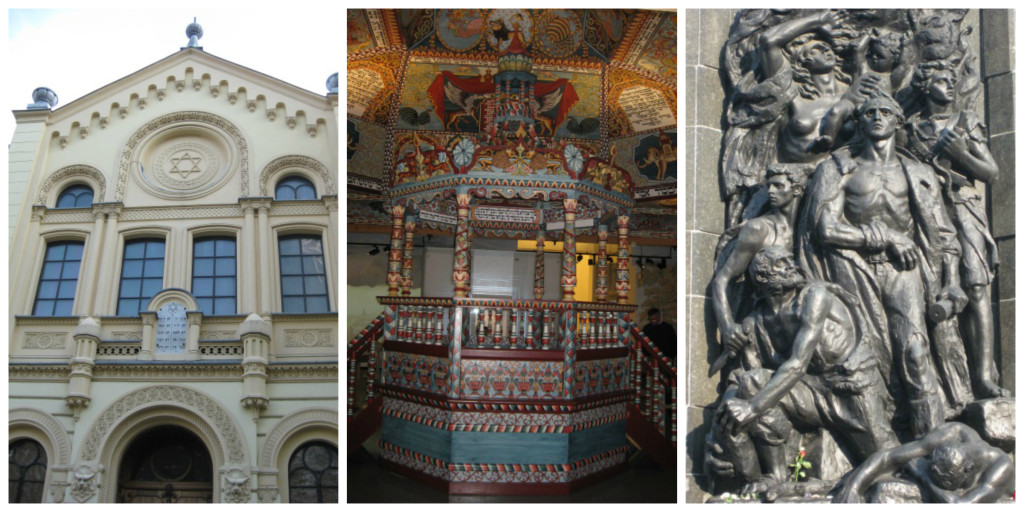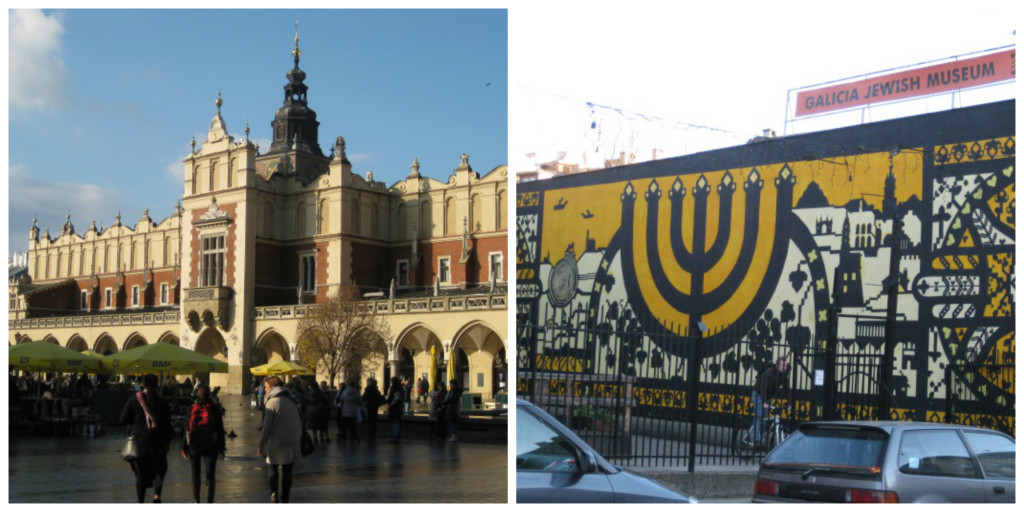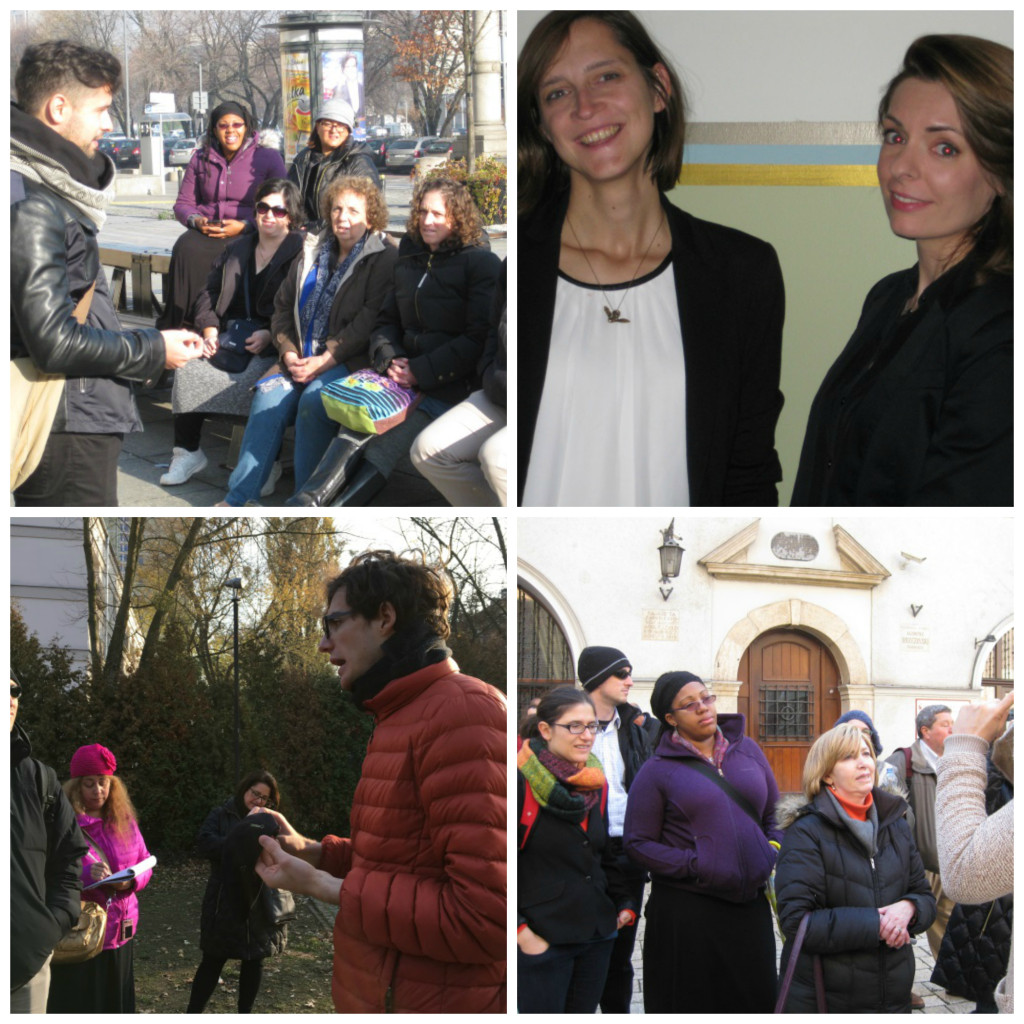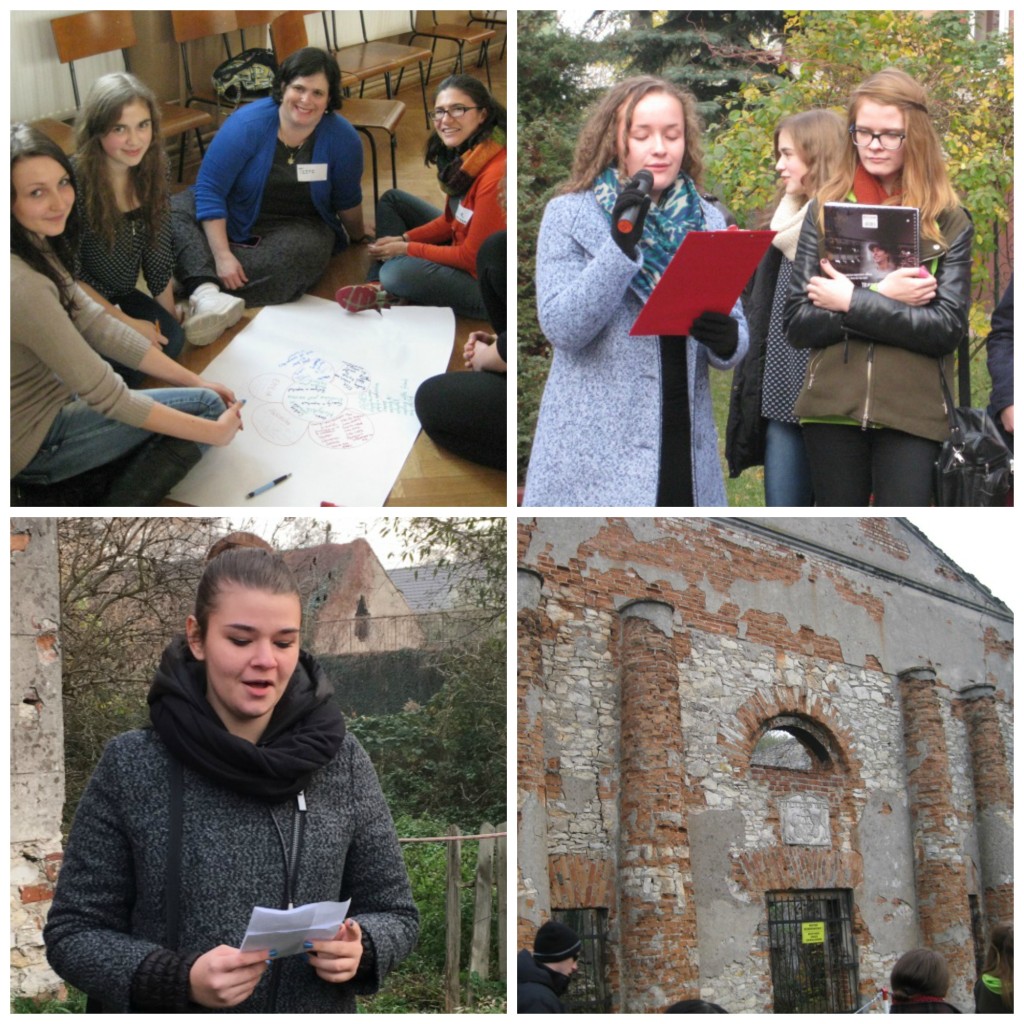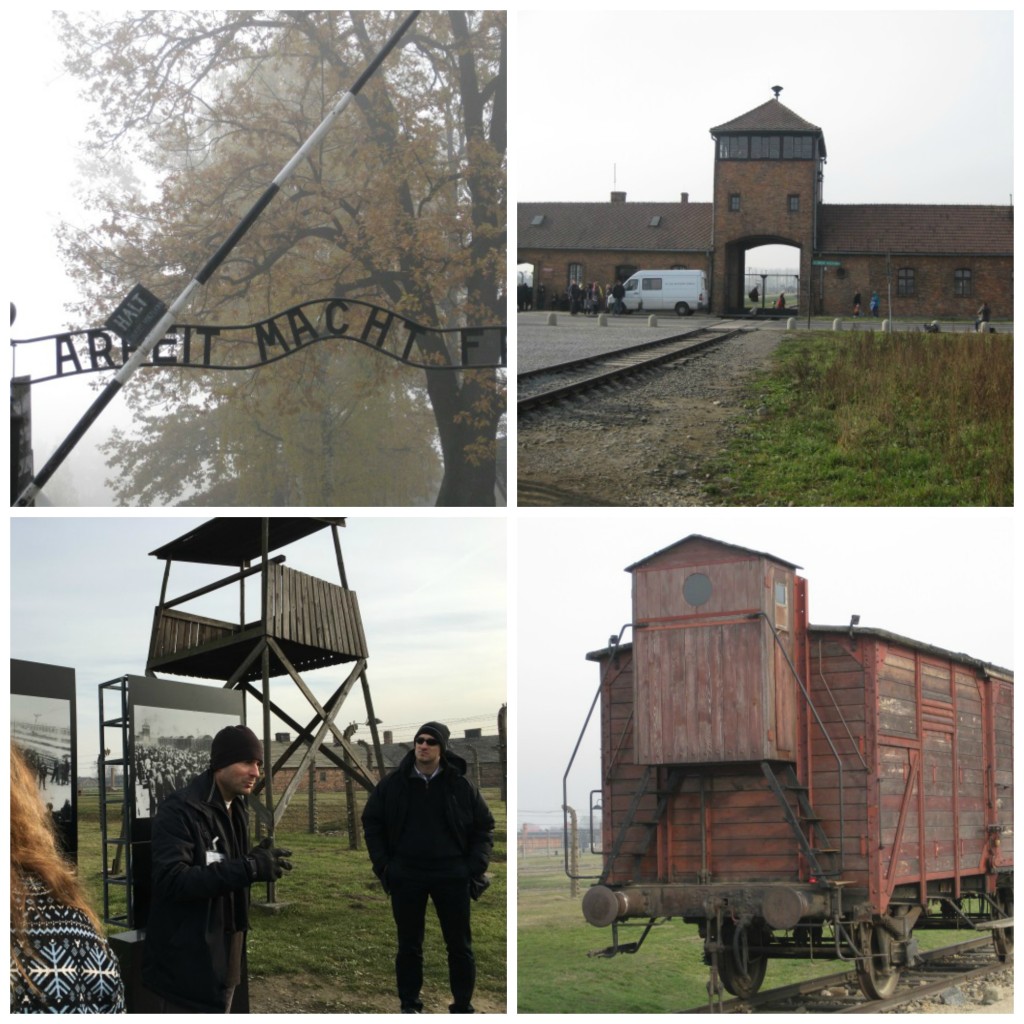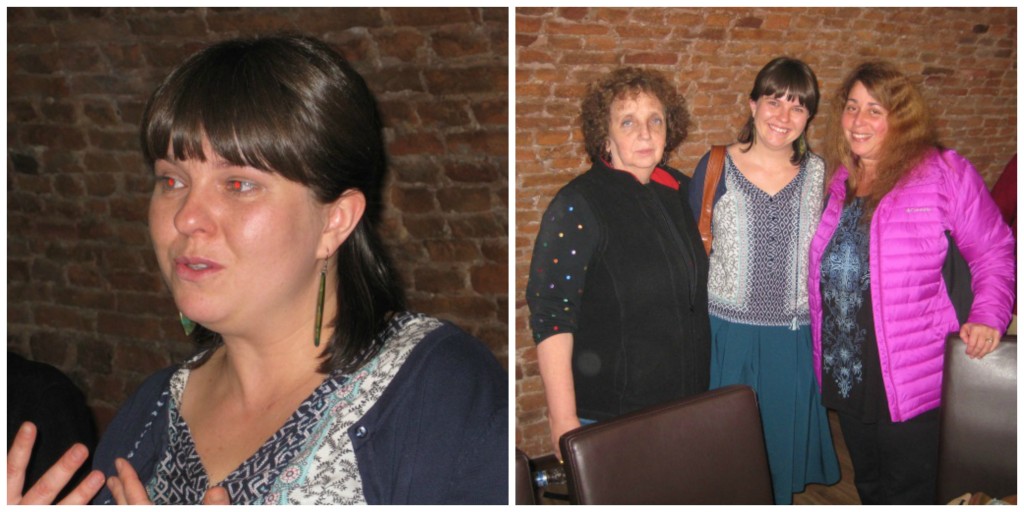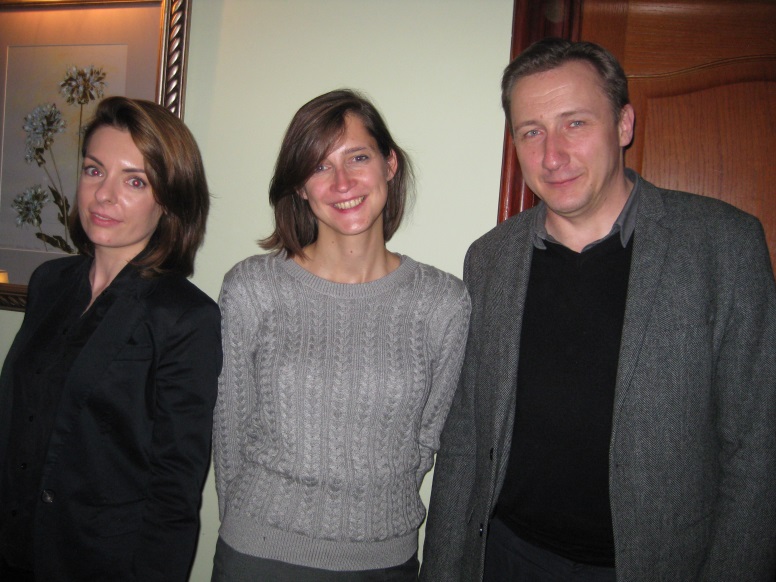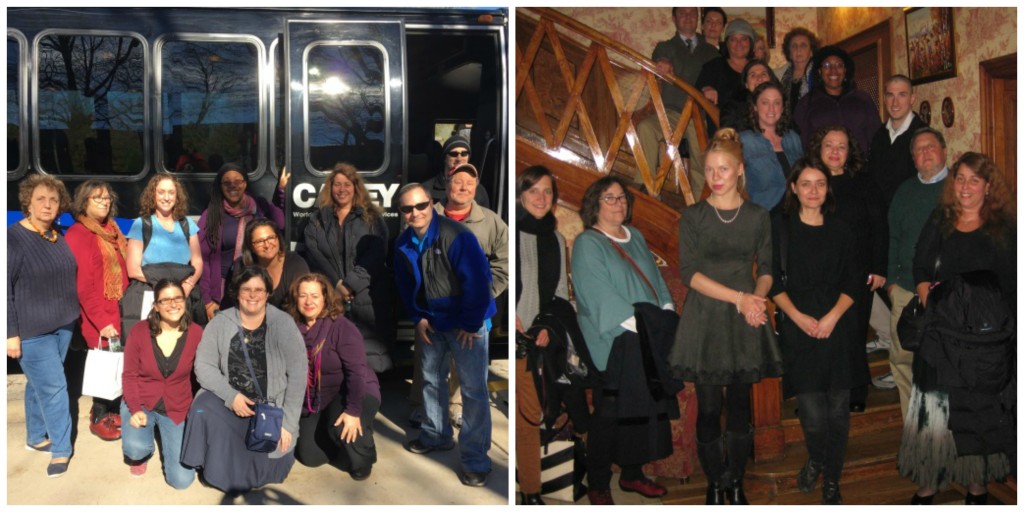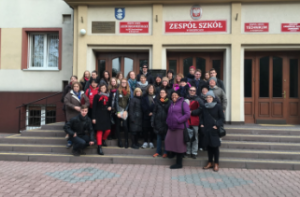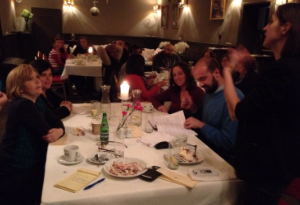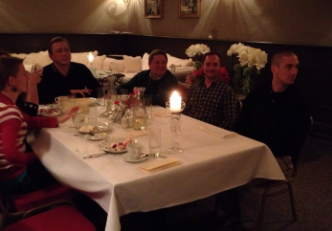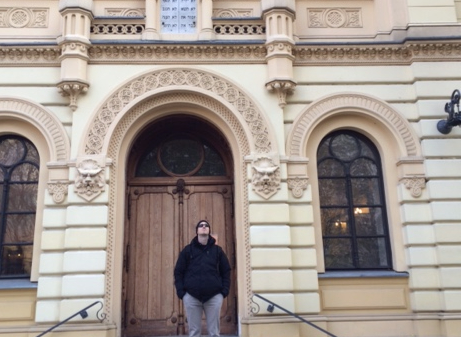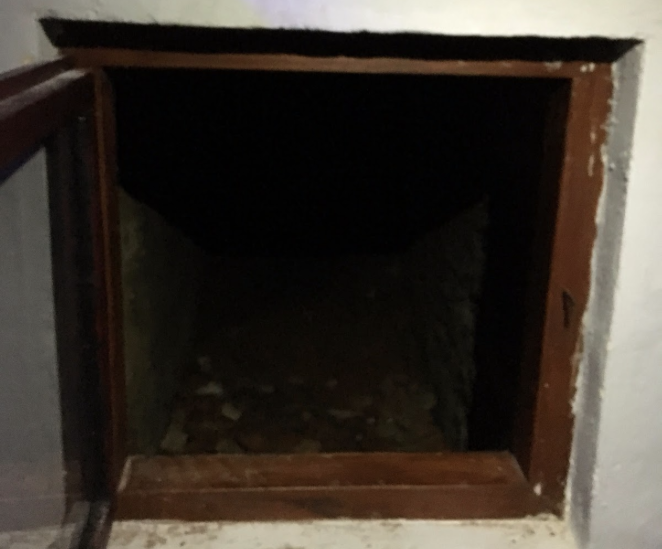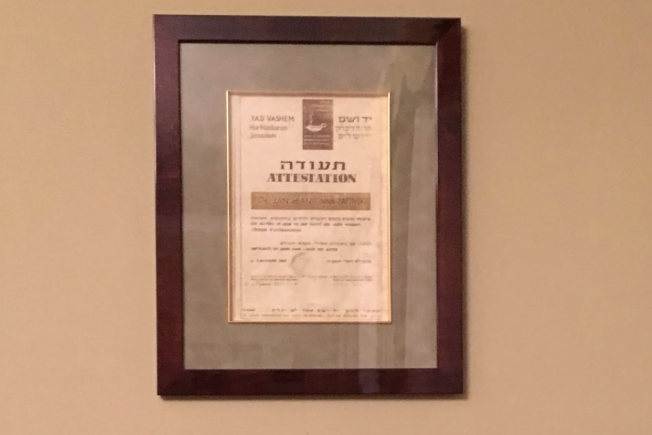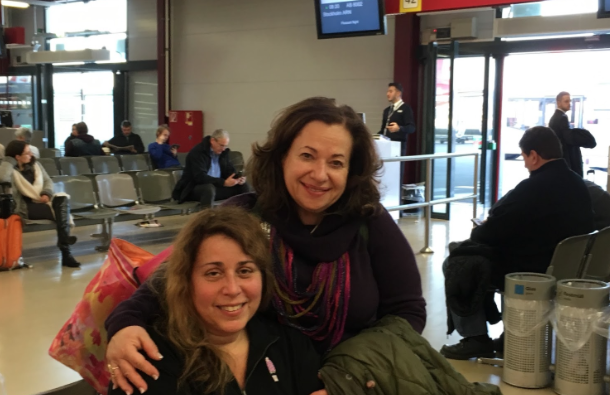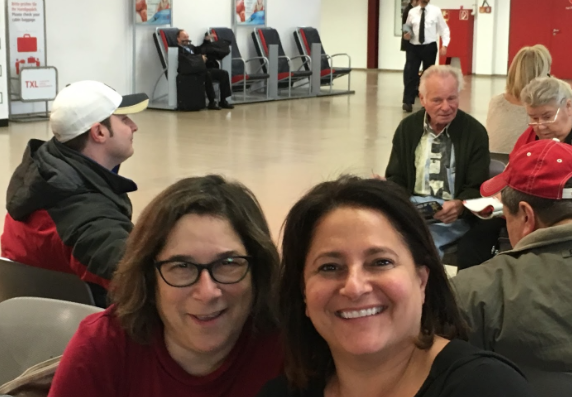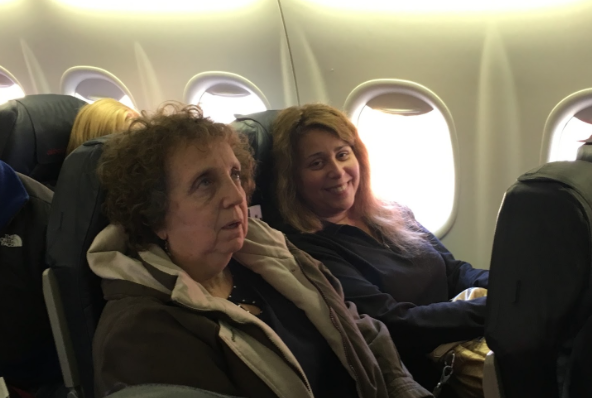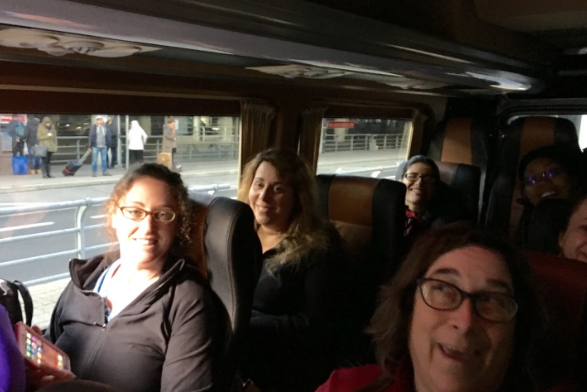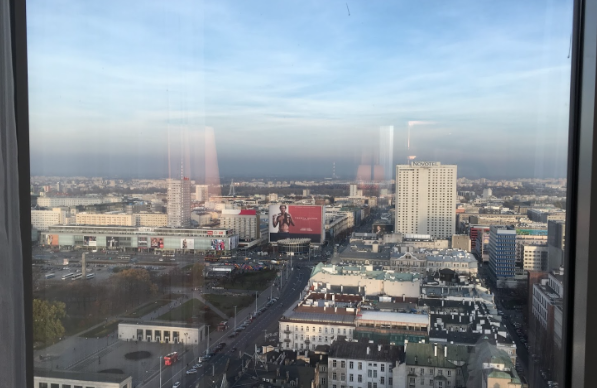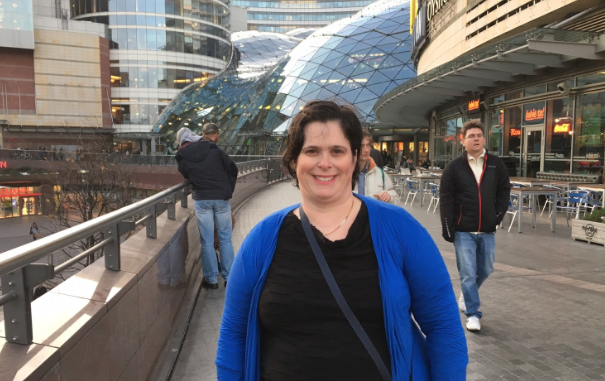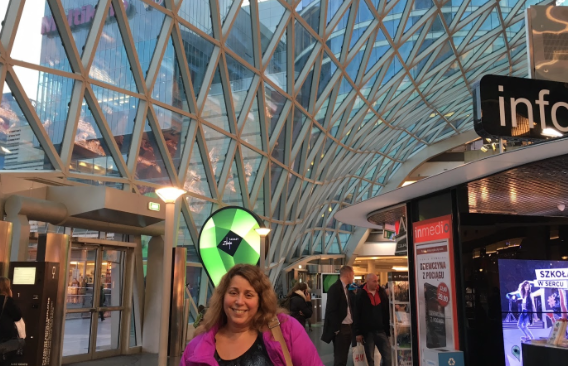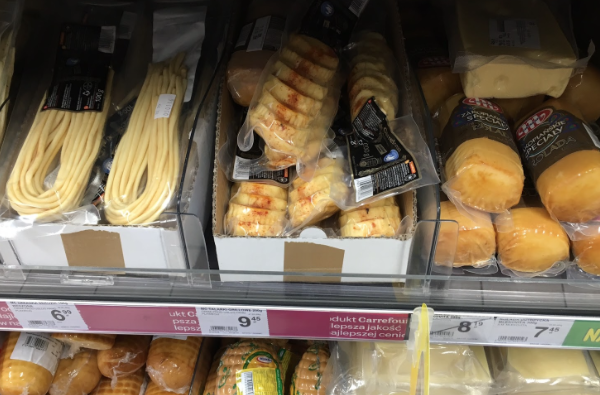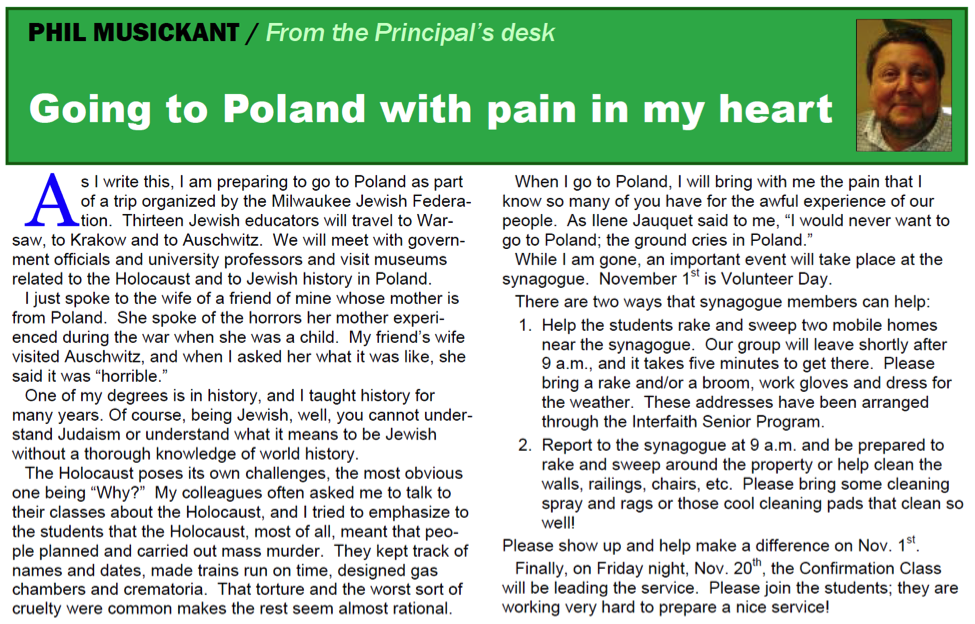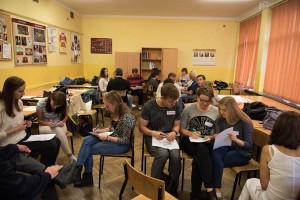
Milwaukee Jewish Educators’ Trip to Poland
Welcome to the Milwaukee Jewish Educators’ Trip to Poland Blog!
Monday, Nov 30, 2015
Reflections on Poland Trip
Reflections on the Milwaukee Teachers’ Trip to Poland sponsored by The Forum for Dialogue Among the Nations and Donors from The Milwaukee Jewish Federation (11/1-11/9, 2015)
Note: Each year on the holiday of Passover, as part of the Seder, Jews sing a song called “Dayenu” about our deliverance from slavery in Egypt. The word “Dayenu” (pronounced die – ay-new) translates “It would have been enough”.
I have voiced my reflections on my recent trip to Poland in the format of our “Dayenu” song – as this trip, for me, was quite a journey of discovery. I entered the trip rather skeptical and hesitant. Although not a direct descendant of survivors, both sides of my family had relatives from Poland and Russia, many of whom perished in the Shoah. I grew up hearing the stories of survivors – and continue to hear these stories – from individuals who refer to the antisemitism they experienced from many Poles. I knew that this would be an agonizing journey. Yet, as a Jewish educator, and one who teaches shtetl life and the Shoah, how could I refuse the opportunity offered to see first-hand the land and sites where so many Jews built a beautiful culture – and later perished? I hoped to learn, I hoped to grow as a human being – and I desperately hoped that something very positive might result from the journey. Little did I expect to have a truly life affirming experience, one that has left me both humbled and enriched.
Had this trip to Poland simply have been a standard scheduled program of historic site tours and lectures provided for a group of Jewish teachers – without the beautiful accommodations and exceptional and elegant restaurants in Warsaw and Krakow (which are usually reserved for donors or tourists of “stature”)…
Dayenu
And if we teachers had only been given an excellent curriculum – a program that was carefully planned to provide us with background on both Polish and Polish Jewish history…a program structured to balance lectures with experiential learning, history with active interactions with a new generation of Poles…
Dayenu
Had our group leaders simply been adequate – versus the outstanding, gracious, intelligent and accommodating individuals that they were… And had not the speakers been so carefully chosen, making sure that each combined keen intellect with a sincere interest in promoting Jewish-Polish dialogue…
Dayenu
Had we only been given the unique opportunity of visiting a town called Krzepice, a former shtetl – where we had the very touching experience of being given a tour of past Jewish sites by young people from the town. Had we not had the incredible opportunity of being the first real Jews these kids had ever met, and had we only had the chance to see how much these young people had discovered about the past Jewish culture in their town through participating in a two- year-project run by the Forum for Dialogue…Dayenu. And had we not had the poignant moment – forever seared in our memories – of standing by the ruins of a former synagogue and cemetery while a Polish student sang “Aveinu Malkenu” in Hebrew…
Dayenu
Had we just had the unforgettable, wretching experience of walking the grounds of Auschwitz/Birkenau, witnessing first-hand the sites of where so many of our ancestors had been murdered … Had we not been guided by Woyzeck, an intense non-Jew who told us that his father had been imprisoned here as a Polish resistance fighter. Had we not all watched Woyzeck forcefully reprimand a teenage tourist callously posing for a photo, telling him his behavior was disrespectful to the dead – and to the living – in this mass graveyard (as if he were a Jew defending his own!)…And had we not had the privilege of joining a fellow teacher of our group – one who carries much pain in her heart for this place – as we communally said kaddish while she lit a yahrzeit candle for her grandmother who perished in this camp…
Dayenu
Had we not experienced a revitalization of Polish Jewry at the Krakow JCC, where we participated in a Shabbat dinner gathering of over 100 people…And had we not been served our meal by non-Jewish students, young women who volunteer weekly for this task and are surprisingly and genuinely interested in Jewish culture… And had we not also heard speakers from the Forum who had, themselves, discovered Jewish ancestry in their families and were now leading Jewish lives…
Dayenu
Had we not had the pleasure of listening to Karolina Panz, a young mother and PHD candidate who described how she became involved, through her studies, in learning about antisemitism in Poland. Had she not, quietly and humbly, told us how she became determined to discover the names of every single Jew who had lived in her town – to preserve their memories. And had we not witnessed her sorrow as she related stories she learned about the persecutions of Jews in small towns…
Dayenu
And had our group of 13 educators simply had the privilege of meeting and conversing with so many exceptional, exceptional individual Polish people who work for the Forum for Dialogue – from Andrzej, the Founder and President of the Forum, and a truly remarkable man of great insight, fortitude, and the highest caliber – to our lovely group leader, Olga (herself a PHD), who tirelessly answered our unending questions and always managed our group with a smile – to patient Renata, who assisted Olga in making sure that everything ran smoothly and our needs were beautifully met – to the marvelous lecturers and guides who were chosen for us throughout the week…
Dayenu!
It is truly this last factor – the incredibly intelligent, warm, sincere and open-minded individuals we were exposed to – that made this trip so unforgettable and will leave each of us with a positive lasting imprint of what true goodness human beings are capable of. In Poland, we teachers were exposed to many individuals who feel a sincere responsibility to deal with a part of Poland’s past that is not easy to face. While one aim of the Forum is to teach us the Polish perspectives of their own history – before, during and after World War II – they did not shirk from the responsibility of facing the fact that there were many Poles who committed atrocities against their Jewish neighbors, many Poles who economically gained from the Jews’ misfortune, and many Poles who simply stood by impassively. Yes – Poland had the largest number of Righteous Gentiles (it also was home to the largest number of Jews). Rather than focusing attention on the Righteous of Poland – which would have been the easy path – this valiant organization puts its emphasis on trying to look at the entire picture and on educating their young. The Forum – by going into schools and instigating educational programming about the Jews who once lived in those towns prior to being annihilated – is trying to ensure that the next generation will not repeat mistakes of the past. By teaching children about the Jewish civilization that was part of the heartbeat of Poland, and so much a part of their own towns – the Forum is attempting to resurrect the memory of the countless Jews who perished there. By involving Polish youth in social action projects to revitalize and care for Jewish sites and cemeteries, the Forum demonstrates to its next generation that one must take responsibility and action where wrong has occurred in the past, and that one must view history with accuracy before one builds anew.
While we cannot be so naïve as to believe that anti-Semitism has totally vanished in Poland – even today, with the absence of Jews – we can, at last, feel some hope. As American Jews, we must applaud, encourage and support the Forum’s efforts to mend relations and to build bridges for the future. Yes, we must never forget. That is our obligation to all those innocents of our people who were brutally and senselessly annihilated. Yet, we can open our hearts to members of a new generation who are courageously taking steps to repair – and to heal.
Written by Laurie Herman
Monday, Nov 16, 2015
Reflection on Poland Trip
It has been exactly four days since I said goodbye to the most amazing group of educators from Milwaukee.
It was a great privilege to meet you all and spend this intense, eye-opening week in Warsaw, Krzepice, and Kraków. There really are no words to describe the mix of emotions; the feelings of closeness, gratitude and mutual respect. For me this has been the most transformative experience and I am very grateful for the opportunity I received from Forum to participate.
To understand your perspective and be with you in places such as Auschwitz, the Jewish District in Krakow, or the Warsaw Rising Museum, to share those moving moments, to reflect on it later, to see a whole new sensitivity – this all made a huge impact on my own perception of Polish-Jewish relations.
Thank you all for your kindness, patience, endless conversations, respect and generosity. Without a doubt I now feel ever more inspired to continue my cooperation with Forum.
-Written by Renata (trip leader)
Thursday, Nov 12, 2015
Reflections on Poland Trip
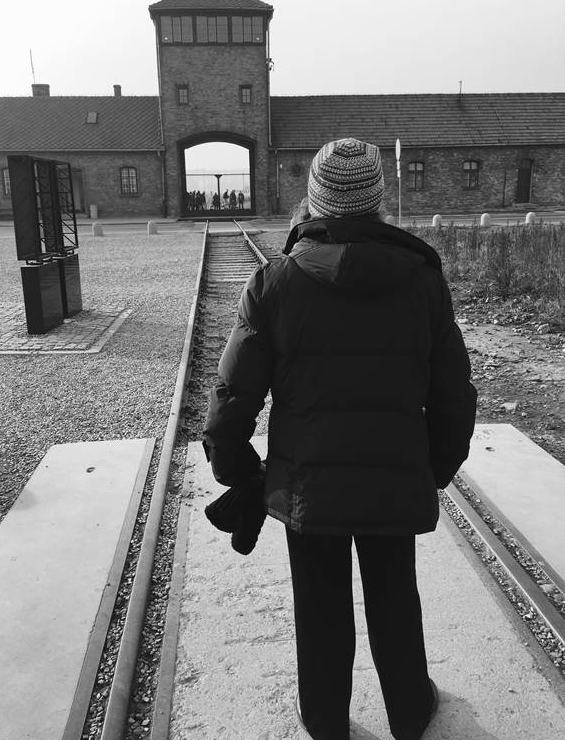 From the Desk of Jennifer Saber who participated in the Milwaukee Jewish Educators’ Trip to Poland in November 2015.
From the Desk of Jennifer Saber who participated in the Milwaukee Jewish Educators’ Trip to Poland in November 2015.
I generally walk around my world with a “glass half full” attitude. But entering into this experience I grappled with how to turn very sour lemons into lemonade. 23 years ago was my first time in Poland as a teen on BBYO Eastern Europe Israel Summer Institute. When I was asked to participate in the Milwaukee Educators’ Trip to Poland and revisit a place with negative associations I didn’t hesitate to say yes. I wanted to return with fresh grown up eyes. As I reflect back on my most recent trip, it would be easy to dwell on the hatred, violence and heartbreaking details. Standing in the gas chambers at Auschwitz bearing nail scratches on the walls. Or walking tours of Krakow and Warsaw, searching around for signs of Jewish residents long gone (like passing a doorway to find an empty, narrow gouge on the door frame). Or share with you the constant reminder that left leaving chills- “we are walking on a cemetery”. Or visiting the Galicia Museum where the main photo exhibit featured images of extinct Jewish life- an empty field where a mass grave lies underneath or a burnt out skeleton of a building that was once a vibrant synagogue.
I want to share with you the highlights of the trip that were the “high”lights, moving away from these “low”lights.
- Our group visited Krzepice High School in the former shtetl of Krzepice for the Forum’s School of Dialogue Program. Through a series of workshops non-Jewish Polish teens learn about the rich Jewish Polish history of the past. They engage in independent research to uncover the forgotten and neglected Jewish heritage of their own hometown’s pre-war Jewish community. They interview eye witnesses and search for information in libraries and archives, all in the name of raising awareness. These inspirational teens conclude their project with a Jewish tour of their hometown for family and friends. We went on one of these tours. I am in awe of these teens for their efforts to preserve the memory of the local Jewish community.
- Celebrating Shabbat in Krakow turned my tears of sorrow into tears of joy. We sang, prayed and feasted at the Krakow JCC with young and old from the local Jewish community. An elderly lady delivered a d’var Torah. The JCC Director shared stories of reemerging Jewish life. We heard about the upcoming events at the JCC- a film with a talkback led by the movie director, a photo contest around the Shofar sculpture donated by the Milwaukee Jewish Community (it’s in the JCC’s courtyard). I bought a t-shirt just like the ones that fill my drawers (from American JCC’s) to help spread the message about the existence of this thriving JCC, hoping when I wear it I am asked questions so I can talk about my positive experience there.
- But the highest of “high” lights of my trip happened right back in a classroom at CBINT. Kitah Zayin (seventh grade) is studying the Holocaust this year. I stayed up late (a seven hour time difference) and phoned into the classroom to talk about my experiences in Poland. Also in the classroom were Denelle Carriger (Kitah Zayin teacher) and Omer Saida (ShinShin). The three of us worked together to lead a discussion that brought the Holocaust off the pages of the textbook to life for the students.
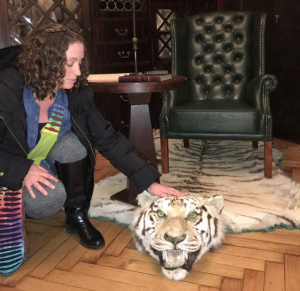
On the trip we spoke a lot about our Jewish roots. What are your Jewish roots? Where is your family from? Share personal stories with your children. Encourage your children to question family elders for family origins. Find places of origin on a map.
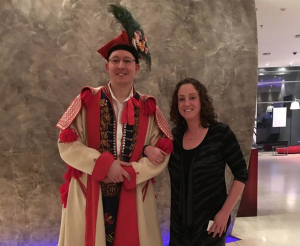
To answer my own question, “how do I turn very sour lemons into lemonade”? The answer is to bring my weeklong experience in Poland back to the community. I use the “high”lights and “low” lights to educate our children about pre and post war life in Poland. The dream is to work with the Forum for Dialogue (who organized the trip) to build a bridge between Milwaukee and Poland by creating co-programming for our children on both sides of the ocean. For the children, I hope this educational experience will transform the nightmares of Polish past into the day dreams of a percolating vibrant Jewish communal presence in Poland.
-Written by Jen
Wednesday, Nov 11, 2015
Reflection from Olga, tour leader from the Forum for Dialogue
 For all of us at the Forum for Dialogue it was a great pleasure to host the Milwaukee Jewish Educators group for a very special study trip to Poland. As you know the Forum is dedicated to inspiring new connections between contemporary Poland and the Jewish people. I felt that this visit was a great example of how we can implement our mission. You could see how important your visit was for the students of the School of Dialogue in Krzepice. I am pretty sure that for many of them this was a non-forgettable experience. For me, as one of the Forum representatives who accompanied the group throughout the week, it was a process of learning and of a continuous dialogue and I appreciate the opportunity engage in conversations about Jewish past and present in Poland, about Polish identity, the state of the country and its society today and about perspectives for the future. Above all, it was a privilege to build personal bonds with this amazing group. Thank you all for taking part in this journey and we hope that it is only the beginning of a long lasting relationship.
For all of us at the Forum for Dialogue it was a great pleasure to host the Milwaukee Jewish Educators group for a very special study trip to Poland. As you know the Forum is dedicated to inspiring new connections between contemporary Poland and the Jewish people. I felt that this visit was a great example of how we can implement our mission. You could see how important your visit was for the students of the School of Dialogue in Krzepice. I am pretty sure that for many of them this was a non-forgettable experience. For me, as one of the Forum representatives who accompanied the group throughout the week, it was a process of learning and of a continuous dialogue and I appreciate the opportunity engage in conversations about Jewish past and present in Poland, about Polish identity, the state of the country and its society today and about perspectives for the future. Above all, it was a privilege to build personal bonds with this amazing group. Thank you all for taking part in this journey and we hope that it is only the beginning of a long lasting relationship.
My very best,
Olga
Tuesday, Nov 10, 2015
Reflection on Auschwitz
Visiting Auschwitz was an amazingly strange experience. This is the place where over 1 million Jews perished. This is the place that for many has become the epitome of hatred, death, and destruction. Yet with all this history influencing my perception, my experience was eye opening.
We drove the hour and a half in what felt like coincidental fog/smog, adding to the mystery of what will be my experience. When we arrived, I did not know how to feel; mainly because I encountered at first the snack shop. Our guide picked us up and brought us to the gate and started with a message of extreme importance: this is a place of death and we come here to learn from our mistakes and how we can change the future.
Walking into and throughout the buildings that housed former prison inmates of the camp (a distinction from my perception because there are prisoners, many of which worked on the camp, and those brought in for execution immediately) was horrifying. Exhibitions of piles of hair or children’s shoes shocked. Walking into the first crematorium really put the brutality into perspective.
The remainder of the tour was as humbling as it was horrifying. The sheer size of the camps (there are two distinct portions) really did not even begin to describe the horrors that occurred (the second camp is roughly one square mile for perspective). I know have a more complete viewpoint of what occurred, although this knowledge is not always the best thing to have.
-Written by Noah
Monday, Nov 9, 2015
We are back in the US and on our way back to Milwaukee. More reflection and recap posts coming!
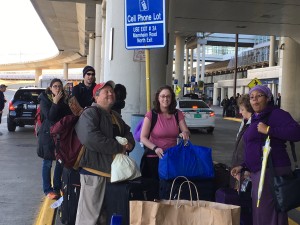

Sunday, Nov 8, 2015
Auschwitz-Birkenau Museum and Memorial Reflection by Aggie
I was terrified at the thought of going to Auschwitz but knew that it was the least I could do. I felt it was my obligation to learn as much I could and to bear witness by being present at the terrible and sacred places where my people as well as the Poles suffered terrible atrocities. Ultimately, I am glad that I, along with my colleagues thanks to the Forum for Dialogue walked the grounds of this memorial. Our presence spoke loudly that we Jews are still here. That we will not forget and we will work harder to make this world a place where people of all faiths and people of color and all children will be treated with respect and kindness.
One of the special gifts of this trip was Wojciech Smolen, our guide, who has been guiding for over 25 years. Is such a thing possible? Wojciech explained that his father was a prisoner of war for over 4 years at Auschwitz. When released, he along with his comrades decided to make this terrible place into a museum so that the world would see and know what really happened. Wojciech continued in his father’s footsteps by becoming a guide. He told stories, gave important background information and explained what is impossible to understand. During our tour he also spoke with an unruly young man and his father about proper behavior and respect in this sacred place.
Wojceich is not just a tour guide, he is doing holy work on behalf of those who can not speak for themselves. He made a commitment to bring awareness to those who are willing to hear and learn. Wojceich, who is not Jewish is doing daily Tikkun. Bringing awareness and understanding of what horrible things the world is capable of. During this week, I learned that there are many more like him.
At this place of brokenness, of pain for us and all the others who suffered terrible atrocities, I learned that Wojceich met his beloved and was now expecting their second child.
-Written by Aggie
Sunday, Nov 8, 2015
Our Final Evening in Poland
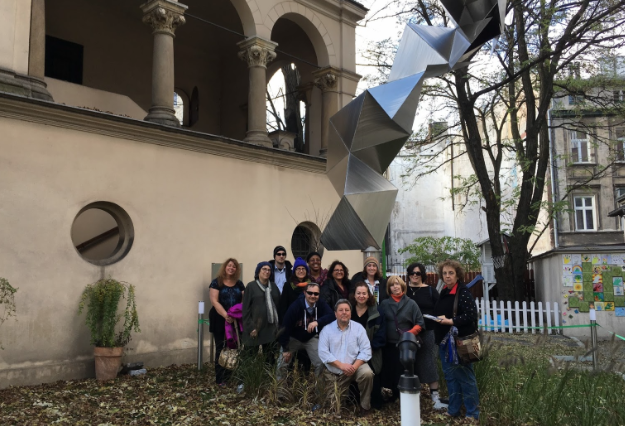 This afternoon we spent a couple of hours reflecting as a group about our time in Poland. We started making plans for how we will share what we have learned with people in Milwaukee. This is a discussion that will continue on the planes and buses tomorrow and well into the future. We concluded with a final dinner where we shared what we have learned, how we have changed, and expressed our profound gratitude to the Forum for Dialogue, our guides, speakers, and especially our leaders Andzej Folwarczny, Olga Kaczmarek, and Ranada Mansa. Each of us feel changed by this trip and we look forward to a long friendship with the people we met in Poland.
This afternoon we spent a couple of hours reflecting as a group about our time in Poland. We started making plans for how we will share what we have learned with people in Milwaukee. This is a discussion that will continue on the planes and buses tomorrow and well into the future. We concluded with a final dinner where we shared what we have learned, how we have changed, and expressed our profound gratitude to the Forum for Dialogue, our guides, speakers, and especially our leaders Andzej Folwarczny, Olga Kaczmarek, and Ranada Mansa. Each of us feel changed by this trip and we look forward to a long friendship with the people we met in Poland.
We leave early Monday morning. Keep watching for blog posts. We will continue to share some reflections after we get home. Thanks for sharing our journey by reading this blog!
-Written by Tzipi
Sunday, Nov 8, 2015
JCC Krakow
We made another stop at the JCC Krakow to take some pictures and to blow a shofar into the sculpture. Watch the video.
-Written by Tzipi
Sunday, Nov 8, 2015
Visit to Oscar Schindler’s Factory
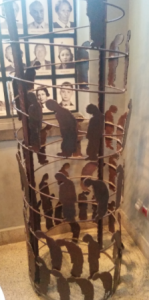 After lunch, we went to visit Oskar Schindler’s factory. I am excited to have the pleasure of writing about this stop because I watched “Schindler’s List” the night before we left for Poland.
After lunch, we went to visit Oskar Schindler’s factory. I am excited to have the pleasure of writing about this stop because I watched “Schindler’s List” the night before we left for Poland.
The building was quite unassuming. I was moved by the outside windows, which featured a face of a worker in each window tile. Like the other Jewish Heritage sites, this was packed!
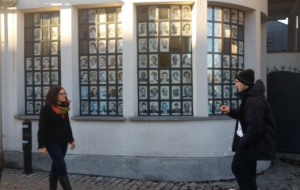 The museum focused on the Nazi occupation of Krakow more than the people that he saved, however it is acknowledged in a few pictures and his honor from Yad VaShem. Being in the building, I, too, felt the line from the Talmud: One who saves a life, it’s as if they saved a world. No one can even count the worlds that Schindler saved. May his memory be for a blessing.
The museum focused on the Nazi occupation of Krakow more than the people that he saved, however it is acknowledged in a few pictures and his honor from Yad VaShem. Being in the building, I, too, felt the line from the Talmud: One who saves a life, it’s as if they saved a world. No one can even count the worlds that Schindler saved. May his memory be for a blessing.
-Written by Tiferet
Sunday, Nov 8, 2015
Lunch with Karolina Panz, Leader of Dialogue from Nowy Targ
I have seen the Holocaust perpetrated at all levels. From the enormity of the barracks at Birkenau, with a forest of chimneys leftover from crumbling wooden buildings to today’s discussion about a small village in the southern part of Poland. We had the pleasure of sitting with Karolina Panz, who is creating a microhistory of the town of Nowy Targ.
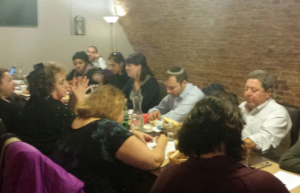
Through meticulous research and archival deep dives, Karolina Panz has decided that she must “stand against how we see our Jewish past.” She is working to not just construct her community’s Holocaust history, but to understand how the Jewish community of 2000 lived in the town. This was a fairly integrated Jewish community and the population spoke Polish. She engages a multiplicity of approaches to discover the town’s history, but relies heavily on oral history to get a sense of their lived experience.
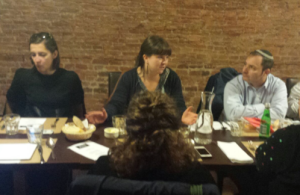
I was awestruck by her description of documents like a electric company record, indicating the change of current following the deportation of the Jews of Nowy Targ. A simple paper shows how life went on for the Polish town, the concern was on billing the appropriate parties, not the thousands of people suddenly uprooted from the village. Without her work, this history would be totally covered. She is working to ensure that these Jews and the specific history of this town are preserved. A true hero.
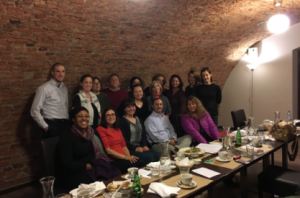
-Written by Ellie
Sunday, Nov 8, 2015
Sightseeing of Krakow Old City
We had a wonderful tour of the Old City of Krakow. This city dates back to the 10th century. Unlike the Old City in Warsaw, the Old City of Krakow was not destroyed during WWII. The buildings we visited were original. Rather than give a long history of Krakow, I will share pictures of some of the beautiful sites.
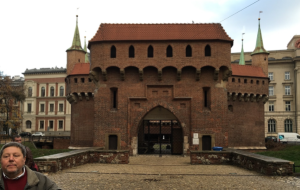
Fortification outside the city walls.
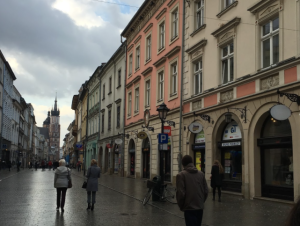
The Old City has an enormous town square surrounded by shops and restaurants.
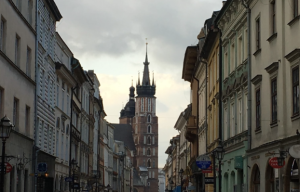
This building is in the middle of the town square. It is filled shopping stalls, much like the Shuk in Jerusalem.
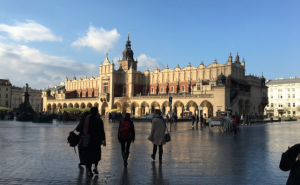
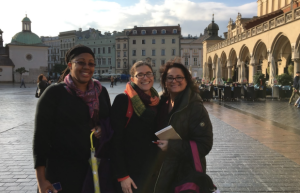
This church shows the many different eras and types of architecture in Old Krakow.
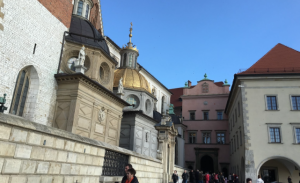
You may be familiar with the story The Golden Trumpet. That story is based on a building in the Old City of Krakow. According to the legend, a boy blew a golden trumpet to warn of an impending attack by the Turks. He was shot through the heart by an arrow as he played. Until today, this (fictional) story is remembered by having a man blow the trumpet every hour from the window. Watch a video of it.
-Written by Tzipi
Saturday, Nov 7, 2015
Phil’s Reflection on Auschwitz
It was humbling to be at Auschwitz. I felt small before the enormity of what happened here. At times I felt as if every step was a desecration, knowing that I was walking where so many walked to their deaths. I won’t bother to describe Auschwitz, as there are plenty of photos to be found and I need not tell again, of what happened there. Instead, I want to talk about a paradox: That Auschwitz has become a “tourist attraction.” 1.5 million people visit every year–the number of people who died there and when we walked through Krakow, we could see stands where one can find a bus to go visit there. Once there, you can buy a soda or candy bar. Thus, at times it seems as if Auschwitz has become a money-making venture for Poland. However, half-way through our tour, our guide told us how his father–a fighter in the Polish underground–survived four years there. He told us that when Auschwitz was liberated, his father and other survivors immediately decided that Auschwitz needed to be preserved, that future generations might also bear witness to the crimes perpetrated there. Then, I decided, if the survivors wanted Auschwitz to be preserved, then context didn’t matter; if candy bars and tourist companies were part of that context, they were also just a small part of the experience and the larger lesson remained unaffected.
-Written by Phil
Saturday, Nov 7, 2015
Visit to Galicia Jewish Museum
We ended the last two hours of Shabbat at the Galicia Jewish Museum in Kazimierz which is known as Krakow’s Jewish quarter. The museum, opened in 2004 offers a look into the past of this particular piece of geography that was a hub of Eastern European life since 1630. The “Traces of Memory” exhibition features photographs by the late Chris Schwarz and texts by Prof. Jonathan Webber (UNESCO Committee Chair for Jewish and Interdenominational Studies at the University of Birmingham, and Professor at the Institute for European Studies at Jagiellonian University in Kraków). Over a period of twelve years, they worked together to gather material that offers a completely new way of looking at the Jewish past that was destroyed in Poland. The exhibition pieces together a picture of the relics of Jewish life and culture in Polish Galicia that can still be seen today, interpreting these traces in a manner which is informative, accessible, and thought-provoking. (website).
The exhibit’s pictures provide a glimpse into the once vibrant community of Jews that lived in this area before the Shoah, and provides haunting images of what now remains. Particularly moving, was a lone tombstone in a Jewish cemetery that was razed by the Nazis; the name of the man buried there was Chaim. That name alone evokes the ongoing message of this trip… Over and over we have seen the attempt to wipe out all of Jewish life yet at the same time, we see signs of that life pushing through the past, much the way a baby tree pushes back into the world after a fire has destroyed the forest. In the part of the exhibit that chronicles life in towns that once had Jewish life two generations ago, we saw a picture of what was once a memorial headstone in a Jewish cemetery, which had been “repurposed” after the war, by a farmer who broke it in half, turned it writing side down and used the stone for a walkway to his home. That farmer’s son-in-law, now the owner of the farm, when he came across Schwarz as he was shooting pictures, offered the headstone to Schwarz, because he felt it was wrong to keep it under the circumstance of what it was and the reason it came into his possession.
Indeed, there has been more than one theme on this trip: today I understood that the traces of memory are powerful and they are a constant reminder to the Polish people of the loss of the Jews. And that while the Poles claim that they are a homogeneous people, it has become glaring apparent that this homogeneousness actually was made up of two peoples, the Poles and the Jews. It may have taken time and living through Soviet domination and recovery from this volatile and violent history, but one of the unexpected things I have experienced this trip, is a true sadness from the Polish people of the first/second generation after the war because of the loss and absence of the Jews. That there is a collective hole in the heart of Poland, a whole which the Jewish people once filled.
When we finished the museum tour, we did Havdalah together as a group. It was a beautiful way to end our Shabbat together. Dinner was just our group (no speaker). Sunday is our last day in Poland. We leave early Monday morning. What an amazing trip.
-Written by Marcie
Saturday, Nov 7, 2015
Aaron’s Reflection Post
Yesterday we had the privilege of eating lunch with Professor Zdzislaw Mach, head of the Center for European Studies at Jagiellonian University. He was incredibly articulate in describing the intricacies of Polish/Jewish Relations especially during and after WWII, but even before the war. He answered two questions I’ve been asking many of the speakers and he answered them in the most satisfactory way so far in my eyes. The two questions were as follows: Is he worried that the new conservative Law and Justice Party who took the Presidency about two weeks ago, will reverse some of the progress Poles and Jews are making in facing their past and the responsibility of Poland to truly understand their Jewish history? He said that although their are about 10/400 members of Parliament who could be considered as having some Anti-Semitic sentiment or if not that far, they just want Poland to stay a Homeogenius country and not accept refugees from Syria or any other religions for that matter.
The second and I believe more complicated question is whether Germany’s attention towards taking responsibility for the past, building museums and memorials, and teaching Holocaust in their schools now in a meaningful way has started to rub off on the Poles and that’s part of the cause of the Jewish cultural revival in the country. He said that Germany has always been a big brother to Poland and they both look up to Germany for many things such as their economy and pays attention to their current events so yes it probably has, but also they fear Germany’s strength and past and resent them for the destruction they caused the country and they know what Germany has been capable of so Poland keeps it’s big brother at arms length.
-Written by Aaron
Saturday, Nov 7, 2015
Lunch with Zdzislaw March, Head at the Center for European Studies, Jagiellonian University
This Shabbat, we had a most illuminating luncheon speaker, Professor Zdzislaw Mach, Head of the Center for European Studies at Jagiellonian University on the topic “Difficult Questions in Polish/Jewish Relations”. Dr. Mach’s excellent presentation really clarified some of the harder issues we’ve been discussing throughout the week, providing information from both a historical and cultural context. He spoke about topics such as “What constitutes Polish culture?”; the origins of Polish antisemitism; the role Polish nationalism plays in Polish-Jewish relations (and why); reasons the topic of the Holocaust is so difficult for Poles; and why so many Poles appear to have “an allergic reaction” to the idea that Poles have some responsibility for wrongs done to Jews during the Holocaust. Dr. Mach explained the above without being defensive.
Among some of the most interesting things that we learned was that Polish cultural identity is based on the Polish language and the Roman Catholic Religion – the latter, which excludes Jews from being a “part” of Polish culture. In the 19th Century, Polish culture centered around literature and poetry that introduced the idea of Poland being like Christ – suffering for the sins of other nations – feeling as though no one could suffer more. This myth, he claims, grew so strong that it is likely part of the reason that Poles have such a difficulty accepting that they could be responsible for doing wrong to others. They feel that they are the victims, that they have suffered repeatedly as a people. In addition, the Jew was always seen as separate. Anti-semitism from the Church blamed Jews for killing Jesus. Poles viewed Jews as helping one another as a separate community, which aided their success in trade. Since Jews in commerce were in direct competition with Christian Poles, here was another cause of Polish antisemitism.
After the war, communists ruling Poland suppressed all discussion of the Holocaust for decades. Most older Poles had no desire to discuss the war – both as it contained painful memories and because many had benefited in various ways through the absence of the Jews (property & jobs). After 1989, younger people in Poland began questioning and examining the actions of many Poles during the war towards the Jews. Many young Poles also wish to rethink Polish identity and recognize that the Jews were an important part of Polish culture that is lost. Last, Dr. Mach stressed that antisemitism is definitely not acceptable in today’s Polish society.
Having almost reached the end of this incredible week, I have to say that based on the exceptional Polish individuals with whom we have come into contact, we have all seen proof of this change in Poland. We have witnessed many people who are making it a major mission of their lives to help repair relations between Jews and Poles, to teach young people in Poland about Jewish culture, and to restore former Jewish sites in Poland. We have spoken with young Christian Poles who are amazingly and sincerely interested in learning about Jews and in finding out more about what happened to the Jews in their country. All of these signs are very positive and have given us hope of great promise for future Jewish-Polish relations. We shall never forget – but a new generation, one that is trying to change through actions, not just words – deserves our notice, our thanks and our encouragement.
-Written by Laurie
Saturday, Nov 7, 2015
Sightseeing of Kazimierz Jewish Quarter
This morning we walked to Kazimierz, the Jewish Quarter of Krakow. Following tefillah in The Temple synagogue we walked around Kazimierz. In addition to The Temple, we saw the Rema synagogue, referred to in Poland as the Remuh synagogue. It was built for Rabbi Moshe Isserles in the 1500s. We also saw the Alte Shul (the Old Synagogue ), and the Isaak Synagogue. All of the synagogues have been or are currently being restored. The synagogues were not only beautiful and unique inside, but they were beautiful architecturally as well.
We saw the building that was the Bait Midrash, the old Mikvah building, the area that was the marketplace, and we also saw a home where Helena Rubinstein lived. We continued on and arrived at the home of Sarah Schenirer, founder and teacher of the first Bais Yaakov School for girls. Formal Jewish education for young woman did not exist at that time. Sarah Schenirer conceived of an idea to correct that problem and established a school which she called Bais Yaakov. We then walked to the building that housed the first Bais Yaakov school.
We walked along the cobblestone streets which were slippery from the rain that began to fall. It was truly an inspiring morning.
-Written by Karen
Saturday, Nov 7, 2015
Shabbat Morning Services at Kupa Synagogue
On Shabbat morning some people went for a jog, some slept late, and some went to synagogue at Kupa Synagogue . When we arrived (before services started, very unusual for me!) there were only 5 men and 3 women there. We waited about a half hour before we had a minyan and could begin. An hour into the service the Israeli girls (about 60 of them) arrived.
The service was lay led as the congregation is currently waiting for a new rabbi. Two members of our group got Aliyot. The service was all in Hebrew and included beautiful singing. We met some interesting people and learned more about the Jewish community of Krakow.
-Written by Tzipi
Friday, Nov 6, 2015
Reflections on Erev Shabbat
On Friday we went to Auschwitz-Birkenau. The tears and heaviness in my heart were the only things with me on the ride home. How could I process this? I felt like returning to the hotel and crawling into bed…but it was almost Shabbat, and our day was far from over. As we stood in the lobby of the JCC and lit candles it became absolutely clear that this was EXACTLY what needed to happen. After candle lighting we walked to the Isaac’s Synagogue in Kazimierz. It was so crowded: youth groups from Israel, Jews from Krakow, tourists from other countries, and us- thirteen educators from Milwaukee, WI. As I looked down from the balcony of the Chabad shul, 370 years old, and heard the singing and davening echo off of the walls, I cried tears of joy. We are here, celebrating Shabbat, in Poland, in a synagogue crowded with Jews. Yes- we are here….AM YISRAEL CHAI (the people of Israel live)!
-Written by Susie
Friday, Nov 6, 2015
Discussion with the director of JCC Krakow – Jonathan Ornstein
After dinner, we had a great discussion with JCC director Jonathan Ornstein. He had just returned that morning from Israel. He was there with Mark Shapiro, Rabbi Shari Shamah, and other JCC leaders from Milwaukee who visited Krakow and then went on to Israel. Jonathan told us about the many exciting programs run by the JCC Krakow including (but not limited to):
Tot program twice a week
Sunday school program
Hebrew classes
Films
Senior programs called Alef (most of those involved are survivors)
Second generation programs (called Bet)
Young adult programs (called Gimmel)–they meet in a separate space because they have outgrown the JCC
Weekly Shabbat dinner
Jonathan explained that the Jewish community in Poland is vibrant and growing. He sees a bright future for the Jewish community here. He emphasized that there is very little anti-semitism in Krakow. The building has no security. People feel very safe here. He also told us about plans for a joint project between the Krakow JCC, the Milwaukee JCC, and a JCC in Israel
-Written by Tzipi
Friday, Nov 6, 2015
Shabbat Dinner at JCC Krakow
After services, we walked back to the JCC for dinner. The JCC building is modern, brightly colored, and full of light and life. I think there were about 100 people there for dinner. We sat with JCC members and learned more about the JCC. A d’var Torah was given by Holocaust survivor Pan Zosia. She gives the d’var Torah every week. Before Shabbat, it is recorded and put on Youtube. Here is her d’var Torah for this week’s portion Chayeh Sara: https://www.youtube.com/watch?v=SZdu3aAPsSg&list=PLMLd0xcLNc7GGt7Qao_nniU4hRaJUQK0v .
The JCC is so full of life and was such a contrast to our day at Auschwitz. Before my trip, someone told me that there are no Jews left in Poland. I am confident now when I tell you that she is wrong. There are Jews and there is Jewish life in Poland. By the way, the food was delicious too!
-Written by Tzipi
Friday, Nov 6, 2015
Shabbat Evening Services at Isaac’s Synagogue
We drove directly from Auschwitz-Birkenau to JCC Krakow for Shabbat. This transition was a bit challenging, but ultimately helpful. We light candles together at the JCC. As we stood in the brightly colored building that was bustling with people, I stared at all the flames and felt so privileged to be standing with my colleagues, my friends, to welcome in Shabbat. Each flame was a promise for the future of Judaism, here in Poland, and around the world.
Most of us walked to services at Isaac’s synagogue. The building was so crowded that we almost didn’t find seat. In addition to their regular minyan, the building was filled with almost 100 Israeli teens. We had seen them earlier in the day at Auschwitz and now we met them again for Shabbat. Their smiles, energy, and ruach (spirit) was very uplifting. The service was led by an Israeli rabbi who was travelling with the teens. Before each prayer, he gave a commentary in Hebrew to put the meaning in context for the kids.
The synagogue building itself was beautiful. There were murals painted on the walls and the ceiling. I don’t have any pictures (it was Shabbat), but the setting was magnificent. Services helped me move past the sorrow of the day and meet the Shabbat Queen with joy and peace.
The synagogue has an interesting history:
“The founder of the synagogue is the hero of a well-known legend deriving from the Tales of 1001 Nights. Ayzik Jakubowicz, a pious but poor Jew, dreamed that there was treasure hidden under the old bridge in Prague. Without delay, he made his way there. On arrival, it turned out the bridge was guarded by a squad of soldiers and that digging was out of the question. Ayzik told the officer about his dream, promising him half of the booty. The officer retorted, “Only fools like Polish Jews can possibly believe in dreams. For several nights now I have been dreaming that in the Jewish town of Kazimierz there is hidden treasure in the oven of the home of the poor Jew Ayzik Jakubowicz. Do you think I am so stupid as to go all the way to Cracow and look for the house of this Isaac the son of Jacob?”. Ayzik returned home immediately, took the oven apart, found the treasure and became rich. After this it was said: ‘There are some things which you can look for the world over, only to find them in your own home. Before you realise this, however, you very often have to go on a long journey and search far and wide.’
-Written by Tzipi
Friday, Nov 6, 2015
Visit to the Memorial and Museum of Auschwitz-Birkenau
This it the first of a few reflections on our visit to Auschwitz-Birkenau. This was an experience that will take time for us to process. Others will add their reflections in the coming days.
From the moment I found out I might be going to Poland, I have been trying to prepare myself to visit Auschwitz. But how does a person prepare for such a moment? I read books, I watched movies, I have heard stories from many survivors, but how could I possibly be ready for the feelings that would come from being in such a place?
Soon after arriving, we saw the famous gate with the words “Arbeit Macht Frei” (work makes you free). I thought of how many of my people walked through these gates and my heart felt heavy. But the tour had hardly begun.
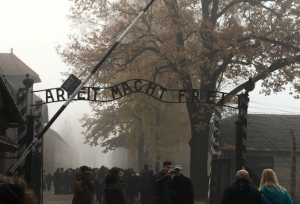
The beginning of the tour included walking through old barracks . . . the original brick barracks of Auschwitz I. The barracks were set up like a museum. First there were pictures. Then there were the huge displays of the items taken from the victims: hair, eye glasses, suitcases, hairbrushes, it went on and on. My heart felt heavier, but it still felt like a museum.
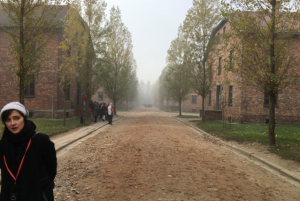
Then we walked through barracks and looked through glass at how the rooms were set up when the Death Camp was still in use. My heart got heavier, but worse was yet to come.
We visited the gas chamber and crematorium. The moment I walked in, I started to sob. This wasn’t a museum, this was pure horror. This was real life. This was the tragic end to so many of our people. As I looked around I felt surrounded by the souls of so many who were murdered here. I looked at the ovens and was overcome by emotions. Outside of this place of horror, Sara Minash, the daughter of survivors, told us the story of how her grandmother died here. She gave up her life to save her daughter. Sara lit a candle and we said Kaddish together.
Next we took a drive to the other half of the camp, Birkenau. Here we saw the railroad tracks that entered the camp.
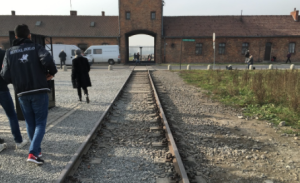
We walked into a barrack, unchanged since the war. I walked on the same dirt floors as so many Jews before me. I touched the wooden bunks. It was so very cold . . . much colder than outside.
There was much more to our 5 hour visit. After this, I couldn’t take more pictures. It seemed almost disrespectful, like taking pictures during a funeral.
I am grateful I had the opportunity to come on this trip. I have learned so much about Poland, the Polish people, and the other teachers on this trip. I left Auschwitz with a deep pain in my heart, but the key is that I left. I was able to walk out of that nightmare and I know that so many others did not. I will return to my family and my work in Milwaukee with a renewed sense of purpose, a fierce loyalty to the Jewish People, and an appreciation of every moment of every day of my life. This week in Poland has changed me. I am thankful to God for my life, my family, my friends, and my community.
-Written by Tzipi
Thursday, Nov 5, 2015
Day 4
Thursday: Visit to Krzepice, a former shtetl
After a long bus ride ,we arrived in a small town called Krzepice. There we were warmly greeted by the staff of the school and the students involved in the Forum for Dialogue project.
High school student presenters, Polish educators, and trip participants standing in front of the high school in Krzepice:
We had an ice breaking exercise to get to know the students and they told us a little about themselves and the program. We,in turn, introduced ourselves and answered their questions. They told us that we were the first Jews they have ever met.
The students led us on a tour of what was the old Jewish shtetl in their town. Each offered a presentation at the various sites. We saw some homes, a cheder, two synagogues,and a memorial to those killed by the Nazis.
Memorial in the square where Jews were forced to gather before deportation by the Nazis:
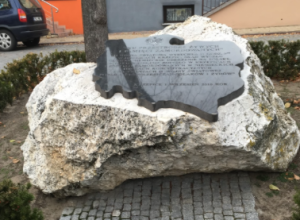
Krzepice City Crest in the square (notice the Jewish stars)
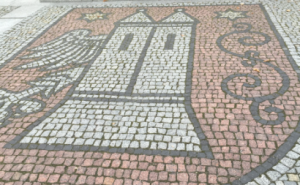
At the second synagogue site we could see the remains of the shell of the synagogue and the inside where the Aron Kodesh (ark for the Torahs) stood. One of the students sang a beautiful song.
High school student presenters, Polish educators, and trip participants standing in front of synagogue ruins:
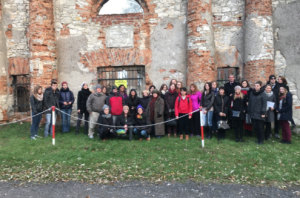
The ruins of the synagogue are inscribed with the words “How full of awe is this place.” What an apt description.
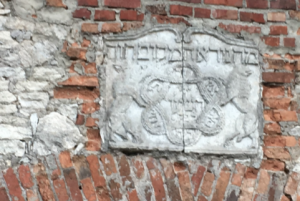
Synagogue ruins
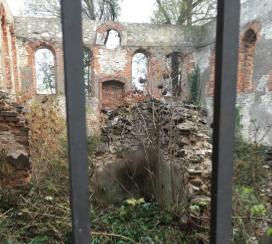
We continued from there to the Jewish cemetery. The students have taken responsibility for the upkeep and maintenance of the cemetery following the guidelines given to them by the Chief Rabbi of Poland, Rabbi Mordechai Yosef Schudrich. The teachers have committed to working on this project and have done so for the last 15 years.
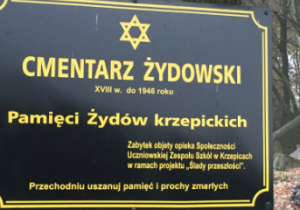
The headstone of a Cohen
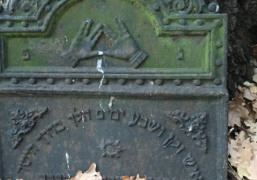
As we visited the cemetery and placed stones on the graves, we said Tehillim (psalms) in Hebrew and English which was translated into Polish and concluded with the recitation of Kaddish.
It was a very moving and powerful day.
Putting a rock on a headstone to remember the dead.
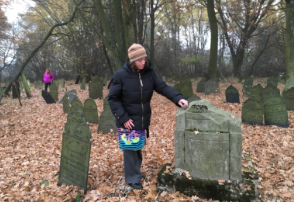
We won’t be able to write again until after Shabbat. We will everyone reading this Shabbat Shalom.
-Written by Karen
Thursday, Nov 5, 2015
Day 4
Wednesday Dinner: Presentation of Forum’s Educational Program, the School of Dialogue
This last evening in Warsaw, as in every evening here, we were invited to a dinner in a beautiful place with very special good food. We are aware and thankful for the preparation and personal thought that the was expressed in it . This evening as we were introduced to the very dedicated educators of the Forum for Dialogue. We learned about the very interesting and important work that they are doing to help young people in the smaller cities in Poland to learn about their past that includes the beautiful facts about the many Jewish people that used to leave near and with their grandparents .
We watched a video of a young woman in little city in Poland who participated in the program. Before the School of Diologue, she never knew anything about our mutual past. She sang the song Kol Haolam Kulo (The world is like a very narrow bridge, and the main thing is to never be afraid) a song sung by Milwaukee children at school, synagogue, and camp. As beautiful as Sarit Hadad sang, my tears refused to stop coming down. You can watch the video here: https://vimeo.com/98330438.
-Written by Sara
Thursday, Nov 5, 2015
Day 4
General Trip Reflections
If you are lucky there are moments in one’s life when you experience things that you never expected, and sometimes those moments can transform you.
Traveling to Poland with Milwaukee educators, with some people who I didn’t really know and who now I can call my friends, to participate in a program that I would daresay most of us were not sure of its content and purpose, to a place that because of the Shoah, I never imagined visiting, has been filled with transformative moments. I would like to share one of them.
On the second night of our visit, the Forum for Dialogue arranged for us to meet with some folks from the Jewish community in Warsaw. We had a lovely dinner together with Monika who works for the Joint Distribution Committee and Estera a young college student shared their stories.

Both women discovered that they had Jewish roots, that their paternal grandfathers were Jewish, but the women had been brought up in Catholic families; through curiosity they started to explore Jewish tradition, Jewish history and they connected to what little Jewish community exists in Poland. They both chose to become Jewish; the college student Estera, is currently in process of formal conversion with the “progressive” community. Both women spoke from the heart as to their yearning to be Jewish, their yearning to be part of Jewish tradition, their yearning to belong to Jewish community and to have their own families become links in the chain of the Jewish people.
As our conversation moved to the reality of what it means to be a Jew in Poland, a land that before WWII had a Jewish population of 3 million people, a land that at the end of the war, the Shoah had killed nearly all of the Jews and as we discussed the very real Anti-Semitism that existed before the war and continues in Poland today, I found myself thinking about the story of Monika and Estera. I reflected on what they represented in the midst of the horror of history and in the presence of ignorance and intolerance of the present day.
The Jewish people are an ancient people. For the roughly 3500 years the Jews have existed, countless times we should have perished as a people; the Shoah certainly almost succeeded to manifest the destiny of Jewish extinction. And Poland was an enthusiastic supporter of making that destiny a reality. Yet here we sat, a group of Jewish people, all observing Jewish tradition and we were with two people who had every valid reason to choose to be anything but Jewish. Indeed, the table discussion was focused on the hatred so many lands have for the Jews, our group is soon to go to visit Auschwitz, a place that is emblematic of the hatred of the Jews. Poland is grappling with its bloody history and yet these two women want to be Jewish; Monika’s young son goes to Jewish school and loves Shabbat, Estera spoke about celebrating Sukkot, they are both working towards building Jewish community. They seem fearless in their decision in the face of history.
In the midst of a trip that has moments that feel like a week long funeral, we had the opportunity to see Am Yisrael Chai, to see the Jewish people live. Battered and diminished, certainly; but the pintele Yid, the ember of Jewishness that lives in the heart of every Jewish soul was present in these Jews in a place where being Jewish was a fatal condition a mere 70 years ago. Torah, which is what we Jews cling too was living with Monika and Estera, they had been transformed by it and they were going to transmit it, no matter how hard that would be.
I was transformed by this encounter. Truly, these two women made my heart soar. In a land where I expected to experience tragedy and despair, I instead encountered just the opposite, I met Monika and Estera, who were as our tradition teaches us to be, prisoners of hope. It is my hope that their story, as I share it now and when I share it with my congregation and my students, will be transformative for all of us!
– Written by Marcie
Wednesday, Nov 4, 2015
Day 3
Polin Museum of the History of Polish Jews
In looking over the schedule for this unbelievable trip, I found myself salivating over the opportunity to see the newly opened POLIN Museum of the History of Polish Jews. I was introduced to the Museum at the Conference of American Jewish Museums conference in March via Skype and I couldn’t wait to see how the real thing was. We opened our visit by hearing from Joanna Fikus, Chief Specialist Exhibition Department, presenting the planning process and the changes they have implemented since opening. The Museum fulfills a tall order, 1000 years of Polish history in eight eye-popping galleries. The museum’s building is bright open and with a glassy facade that emphasizes openness and transparency.

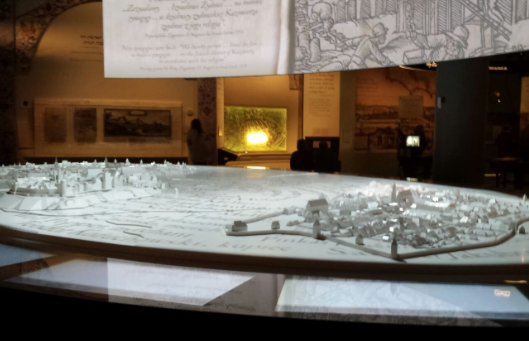
They utilize quotes widely, using the lived experience of everyone from Benjamin of Tudela, the Ba’al Shem Tov,and David Ben Gurion. The diversity and array of interactive components and supplemental information is extraordinary. I was particularly taken with the way they constructed books using primary sources that allowed me to thumb through edicts from Polish nobility or illuminated manuscripts.
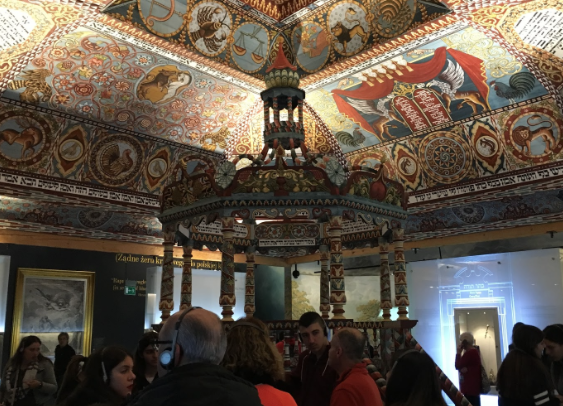
The showstopper is an unbelieveable recreation of the Gwozdziec synagogue. This colorful and intricate installation was modeled after a synagogue that was destroyed in World War I and took over 300 people from 16 countries to make. The details are dazzling, an array of animals and aphorisms. It certainly contests the notions that synagogues were unembellished.
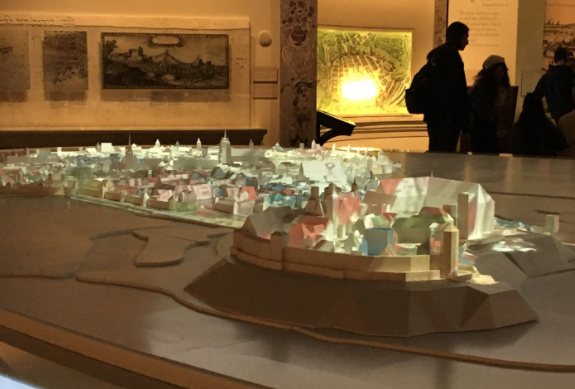
Like so many things on our very busy trip, I could have spent more time exploring–I guess I will just have to plan my return.
-Written by Ellie
Wednesday, Nov 4, 2015
Day 3
Lunch with Pawel Dobrosielski
This afternoon we had the pleasure of dining with Pawel Dobrosielski, a PhD candidate at the Institute of Polish Culture of the University of Warsaw. His doctoral dissertation is devoted to the Polish reception of the works of Jan Tomasz Gross (more on him later). Pawel’s specialty is Shoah discourse and memory in Poland. Fun fact: his last name is a combination of two words: “dobro” which means good and “siolo” which means town, so we know that he is descended from a good town!
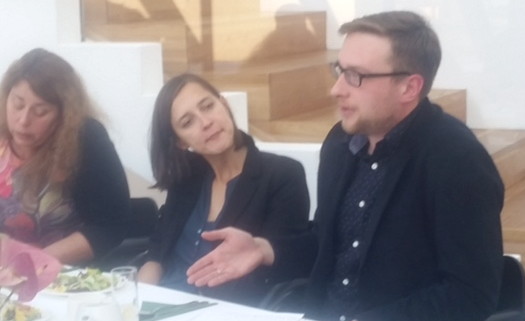
The problem with Polish-Jewish discourse has been the tension between two competing memories. Post-Stalin, the communists placed a “freeze” on Jewish topics, meaning they were not addressed, because they wanted to enforce a class structure, not an ethnic structure. In the 80’s, with the decline of communism in, Polish-Jewish history and themes began to re-emerge in literature. The Polish consensus was to acknowledge that the Jews died in the Shoah, but also to firmly hold that it was not their fault, they were victims, too, and that the issue was that they did not mourn the Jewish loss properly. After 20 years of not having any discourse on the topic, this is not a terrible conclusion! However, we know it’s not the whole conclusion and slowly, Non-Jewish Poles are beginning to have the important national conversations that have brought and, G?d willing, will continue to bring about dialogue and tikkun that this country needs.
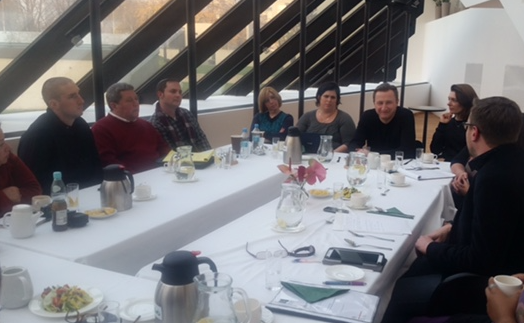 The first conversation was sparked by a Catholic convent that wanted to put crosses at Auschwitz-Birkenau ahead of a visit by the pope. This brought up the question, to whom does Auschwitz belong? Is it just for Jewish memory or does it belong to other ethnicities and religions that perished there as well? The next debate was brought about by the release of Jan Tomasz Gross’s book Neighbors in 2001. For those who don’t know, Jan Tomasz Gross is a Polish-born American historian and sociologist and professor at Princeton University. He is the most important person on Polish-Jewish relations before and during WWII. This book revealed the ugly truth of what happened in the village of Jedwabne, where the people there killed their Jewish neighbors. Half the town killed the other half. This was the beginning of the Polish people needing to consider what role they played in the extermination of the Jews. With the release of Gross’ subsequent books, these conversations happen all over Poland. And not just on the intellectual level, but every day folks as well weigh into the conversations. happens.But, the fact that these conversations are happening is a step in the direction towards greater healing for both parties.
The first conversation was sparked by a Catholic convent that wanted to put crosses at Auschwitz-Birkenau ahead of a visit by the pope. This brought up the question, to whom does Auschwitz belong? Is it just for Jewish memory or does it belong to other ethnicities and religions that perished there as well? The next debate was brought about by the release of Jan Tomasz Gross’s book Neighbors in 2001. For those who don’t know, Jan Tomasz Gross is a Polish-born American historian and sociologist and professor at Princeton University. He is the most important person on Polish-Jewish relations before and during WWII. This book revealed the ugly truth of what happened in the village of Jedwabne, where the people there killed their Jewish neighbors. Half the town killed the other half. This was the beginning of the Polish people needing to consider what role they played in the extermination of the Jews. With the release of Gross’ subsequent books, these conversations happen all over Poland. And not just on the intellectual level, but every day folks as well weigh into the conversations. happens.But, the fact that these conversations are happening is a step in the direction towards greater healing for both parties.
-Written by Tiferet
Wednesday, Nov 4, 2015
Day 3
Sightseeing of Warsaw Jewish Sites
This morning we visited the Nozyk Synagogue which is the only synagogue remaining from Pre-war Poland. It was founded by Zalman and Rivka Nozyk who built it for merchants and others to have a place to worship when coming to Warsaw. It is currently in use and it’s rabbi is the Chief Rabbi of Poland, Rabbi Mordechai Yosef Schudrich.
We went to the Jewish cemetery on Gnshe street which was founded in 1806. At one time it there were 250,000 graves, but many of those graves were destroyed in the war. The cemetery was on the border of the Warsaw ghetto. Some of the graves we visited were Adama Czerniakowa, head of the Jewish Committee in 1939, the creator of Esperanto, Doctor Lazaro Lvdoviko Zamenhoff, and Janus Korchak who was the founder of the Jewish children’s orphanage and IL Peretz,father of Jewish literature.
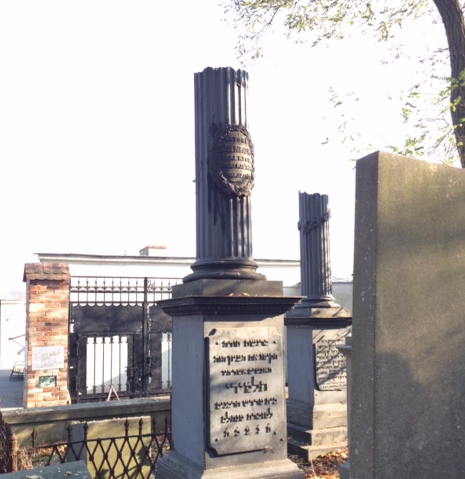
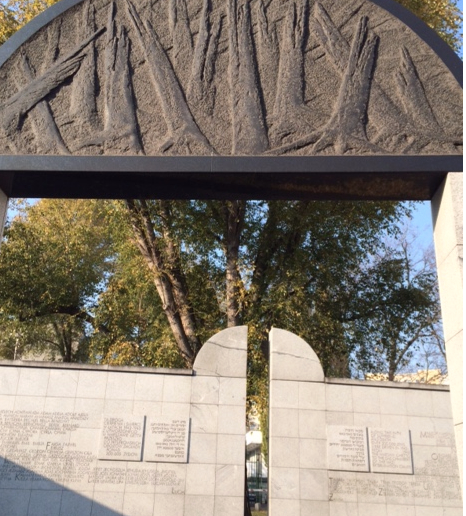
We also went to Umschlagplatz, the gathering place for the Jews before being deported to Treblinka the death camp. These innocent people were tricked into thinking they were being sent to work.
-Written by Aggie
Wednesday, Nov 4, 2015
Day 3
Warsaw Rising Museum
Did you know there were two uprisings in Warsaw? Neither did I. That is, until this morning when our group visited The Warsaw Rising Museum. A year after the familiar Warsaw Ghetto Uprising, Polish residents stood up against the Germans in an attempt to overtake them before the Soviets showed up on their front door to help. The Polish wanted to HOST the Soviets rather than NEED the Soviets to help stop the Germans. Mission failed. It was very eerie to watch the black and white aerial view of a devastated Warsaw in the 3D movie “City of Ruins.”
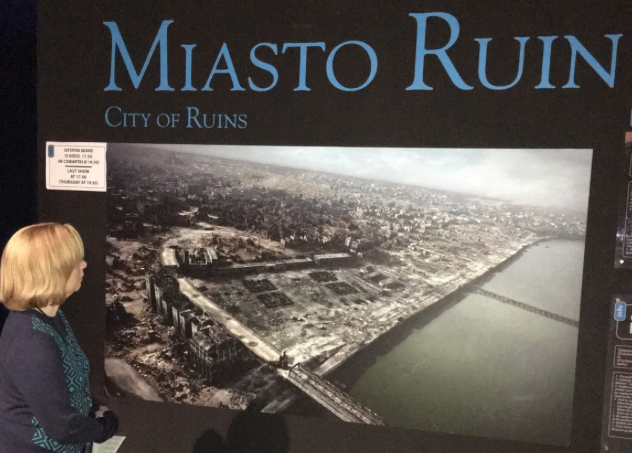
The constant rhythm of a heartbeat was echoing in the museum as a backdrop. Sounds came from bullet holes in this wall. “The ‘heart’ of the museum beats for those who fought and perished.”
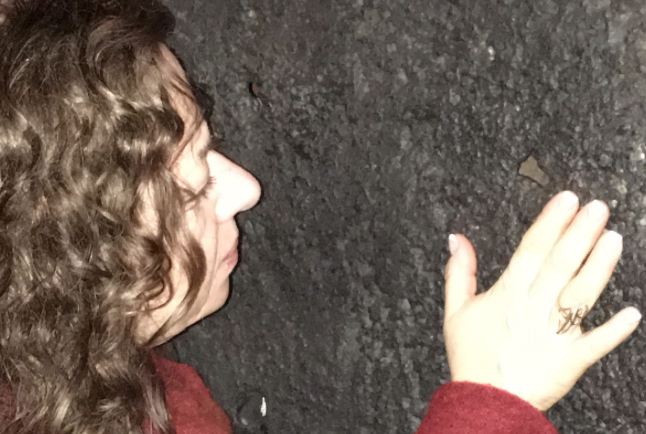
Black and white footage throughout the museum lifted the Warsaw Uprising off the flat pages of the history books and made it a heartbreaking reality.
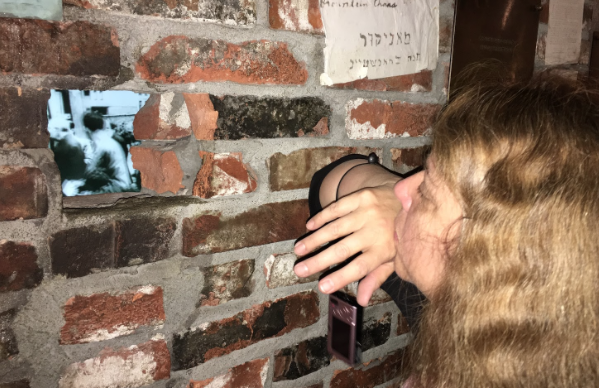
A take away from the museum was a physical one- calendar pages hung throughout the museum to connect the museum goers to the realities of the Warsaw Uprising timeline. Each calendar page listed the events that took place on that particular day.
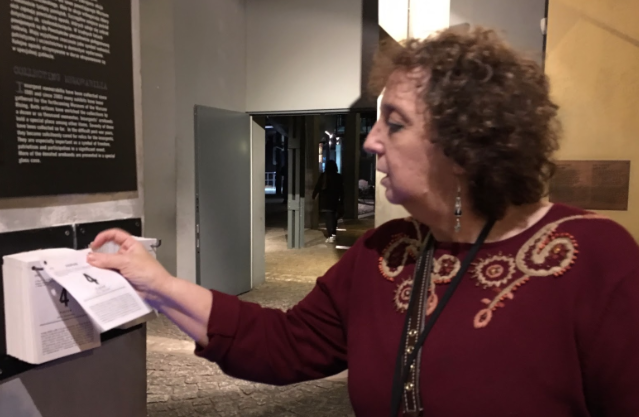
Our eyes met those of the selfless men and women who lost their lives fighting for their right to live freely.
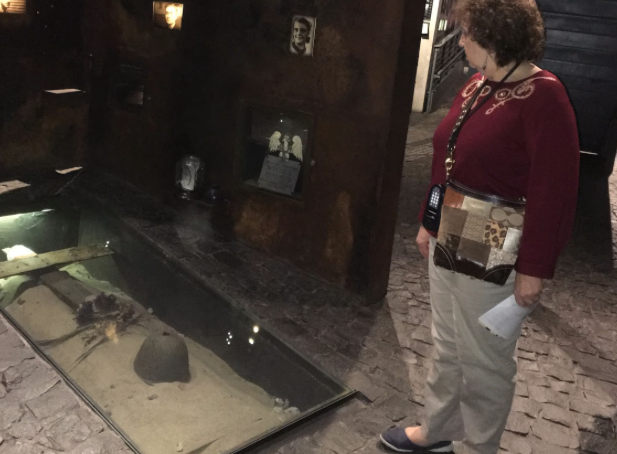
-Written by Jen
Tuesday, Nov 3, 2015
Day 2
Day 2 Post by Susie
 This evening during dinner at Dom Polski, a beautiful restaurant, we had a wonderful opportunity to meet with two lovely young ladies, both involved in the Jewish community of Warsaw. Monika Elliott is the Program Director for the Joint Distribution Committee (JDC) in Poland. Estera Kucper works with the Jewish Youth Organization in Warsaw. Both of them have such interesting and complex stories- unique, yet it some ways, similar. Monika and Estera both grew up knowing that they had Jewish roots, yet grew up in secular homes that did not celebrate any holidays or practiced any of the traditions. They CHOSE later in life to explore and embrace their Judaism.
This evening during dinner at Dom Polski, a beautiful restaurant, we had a wonderful opportunity to meet with two lovely young ladies, both involved in the Jewish community of Warsaw. Monika Elliott is the Program Director for the Joint Distribution Committee (JDC) in Poland. Estera Kucper works with the Jewish Youth Organization in Warsaw. Both of them have such interesting and complex stories- unique, yet it some ways, similar. Monika and Estera both grew up knowing that they had Jewish roots, yet grew up in secular homes that did not celebrate any holidays or practiced any of the traditions. They CHOSE later in life to explore and embrace their Judaism.
In Monika’s role for the JDC, she has done everything from working in Sunday schools with children, leading Israeli folk dancing classes, and organizing large events like Limud- an event that will gather over 1,000 Jews in Poland. She helps to bring Judaism to small towns in Poland that do not otherwise have access to Jewish practices. She organizes a festival called “7@Nite- Night of the Synagogues,” an event that draws 10,000 people to visit synagogues in Krakow.
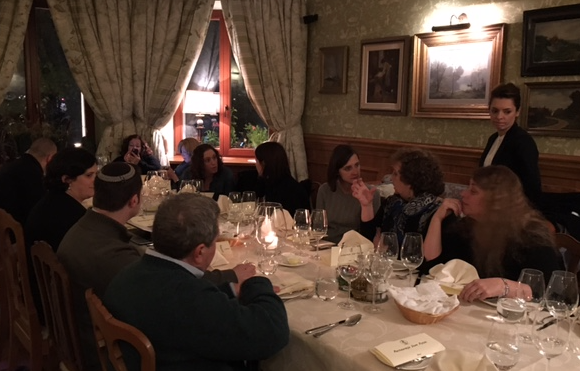 Estera works with the Jewish Youth Organization, a group that seeks to bring young (18-30), Polish Jews together for everything from holiday celebrations to educational lectures and organizing summer camps. She is also involved in Moishe House in Poland and a progressive synagogue in Warsaw, Eitz Chayim.
Estera works with the Jewish Youth Organization, a group that seeks to bring young (18-30), Polish Jews together for everything from holiday celebrations to educational lectures and organizing summer camps. She is also involved in Moishe House in Poland and a progressive synagogue in Warsaw, Eitz Chayim.
They both shared moving and personal stories about how it is that they felt moved to explore and nourish their Jewish souls- it was moving and emotional to hear them share their journeys. It opened up many of our eyes to their experiences as young Jews in Poland. Neither of them reported EVER having experienced overt anti-Semitism. On the contrary they feel very accepted and welcome everywhere, both in their personal and professional lives. As many of us shared that we had heard that anti-Semitism is rampant in Poland, this was very surprising, although they were quick to share that this was truly their own personal experiences and cannot, of course, speak for every Jew in Poland. This was a contrast to other people we have spoken to on this trip who have said that there is anti-Semitism in Poland.
It was a privilege and a learning opportunity for all of us. We have much to think about and to digest after hearing these young ladies personal stories. Personally, I am filled with hope and gratitude that Poland does, indeed, have a thriving Jewish community. I look forward to exploring opportunities for partnering with the community and sharing the lives of Jews living in Poland with our community.
-Written by Susie
Day 2 Post by Laurie
It was very exciting today to have the opportunity to visit a site that very few Americans have seen, as the site opened last April and is only open to the public with advance reservations. Our tour the Zubrinski Villa will likely be one of the highlights of this trip for many of us – I know that it’s definitely a highlight for me. For those who may have read the bestselling non-fiction book “The Zookeeper’s Wife,” the site we saw today was the actual villa where approximately 150 Jews were saved by Warsaw zoo director Jan Zabinski and his wife, Antonia. During the first bombings by the Nazis on Poland, 90% of the Warsaw Zoo was destroyed. Many of the animals were killed, and others were shot by the Polish military for reasons of safety. Jan Zabinski of the Berlin Zoo was brought in to help preserve as much of the zoo as was possible, and to raise pigs on the zoo grounds to use as a source of food. As Zoo Director, he had passes to travel.
Zabrinski had many Jewish friends before the war – and he used his passes and connections with the Polish Resistance to organize and smuggle Jews out of the Warsaw Ghetto and into the zoo grounds – where they would later escape to freedom. Jews hid in the basement of his home, exited from a basement window, and went through a tunnel to the birdhouse – from where they escaped to freedom. Zabrinski also was active in the Polish resistance and sheltered the underground there as well. His wife, Antonia, played piano and would play select songs as a code to warn those in hiding when the Gestapo visited. Zubrinski was honored as one of “The Righteous Among the Nations” at Yad Vashem. In a statement he made after the war, Zabinski said “I risked and gave shelter not because they were Jews, but because they were persecuted…It was my duty as a human being to help them. Common decency.”
The home of the Zubrinski’s
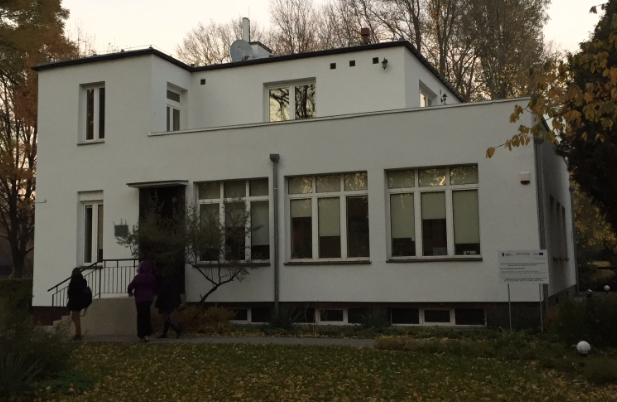
Photo taken in the basement that shows the escape tunnel and a picture of the exit from the tunnel.
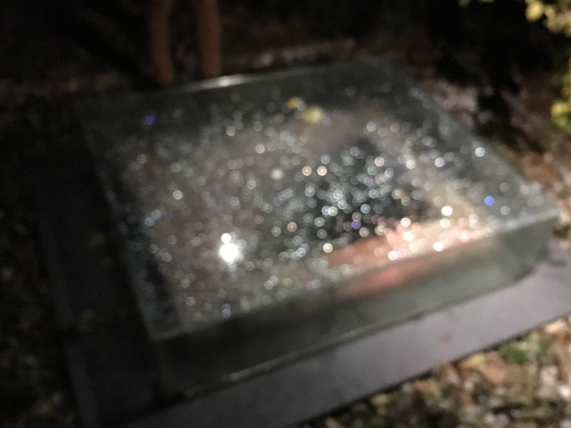
Award from Yad Vashem for Righteous Among the Nations.
-Written by Laurie
Day 2 Post by Phil
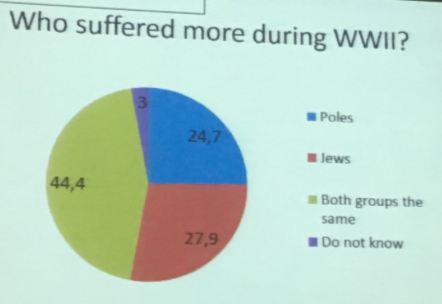 I am writing about the presentation made by Michat Bilewicz, from the University of Poland and the Forum for Dialogue. His presentation was titled, “Representations of History and Culture in Polish-Jewish Relations.” His main point is that Poland is struggling with the issue of whether or not Poles were victims or perpetrators during the war. He presented a complex picture of Polish self-identity regarding what happened during the war and what that means for Poles and Jews, who are also forced to confront the complexities of Polish conduct before and during the war.
I am writing about the presentation made by Michat Bilewicz, from the University of Poland and the Forum for Dialogue. His presentation was titled, “Representations of History and Culture in Polish-Jewish Relations.” His main point is that Poland is struggling with the issue of whether or not Poles were victims or perpetrators during the war. He presented a complex picture of Polish self-identity regarding what happened during the war and what that means for Poles and Jews, who are also forced to confront the complexities of Polish conduct before and during the war.
 The analysis is multi-layered and even had an impact on the recent elections in Poland. For me, I have come to learn that while Poles have been anti-Semitic, today Poles are recognizing how much of Poland’s history and culture is the result of the contributions of its formerly large Jewish population and is making strides to understand it and preserve it.
The analysis is multi-layered and even had an impact on the recent elections in Poland. For me, I have come to learn that while Poles have been anti-Semitic, today Poles are recognizing how much of Poland’s history and culture is the result of the contributions of its formerly large Jewish population and is making strides to understand it and preserve it.
-Written by Phil
Day 2 Post by Aaron
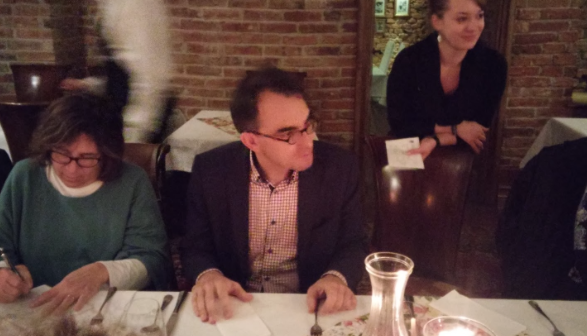 Today for lunch we met with Piotr Buras, head of the European Council on Foreign Relations to speak about what’s happened in Poland since 1989.
Today for lunch we met with Piotr Buras, head of the European Council on Foreign Relations to speak about what’s happened in Poland since 1989.
10 days ago Poland elected a new President from the Conservative Law and Justice Party. Piotr said it marked the end of the transformation period that began in 1989. This more conservative party is more concerned with national sovereignty than being Eurocentric.
In the 90’s there was a movement called Critical Nationalism in an attempt not to hide from the past. The new governing party believes that self-criticism has gone too far and prefers a more “affirmative narration” that doesn’t paint Poles in a negative light.
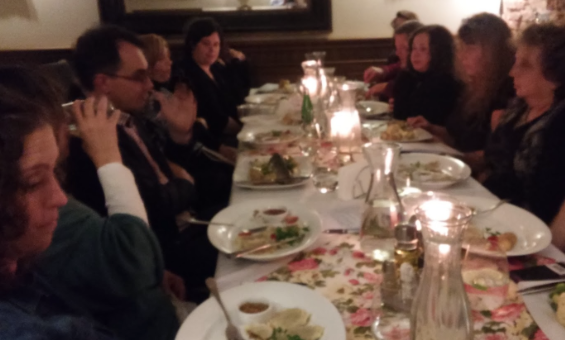 There is still a big low income sector in Poland and Piotr believes the new government was elected because political elites didn’t pay close enough attention to economic divisions and the transformation period produced “exaggerated aspirations”. The new party wants to give incentives for Poles to have more kids, raise foreign banking and business taxes, and raise the level of tax free income.
There is still a big low income sector in Poland and Piotr believes the new government was elected because political elites didn’t pay close enough attention to economic divisions and the transformation period produced “exaggerated aspirations”. The new party wants to give incentives for Poles to have more kids, raise foreign banking and business taxes, and raise the level of tax free income.
The overwhelming political narrative is to catch up to Western Europe and after 25 years even though the economy seems to be doing ok, many Poles, especially the younger generation believe they haven’t reached those goals.
Piotr doesn’t believe the new party in power is anti-semitic and that our understanding of left and right politics doesn’t apply in Poland. Overall Piotr believes that Poland’s new approach to Jewish culture through festivals etc… is a “striking development.”
-Written by Aaron
Day 2 Post by Marcie
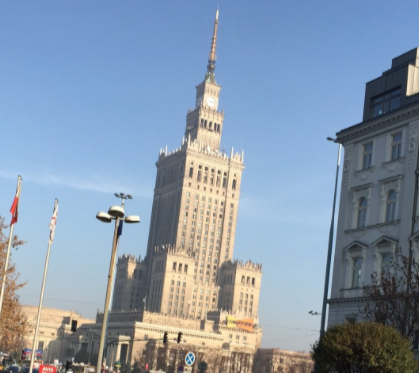 We gathered to take a tour of the City Center and “Old Warsaw”, our first stop was the Palace of Culture and Science, constructed in 1955 as a gift from Stalin after the war and after the Soviet bloc was well established in Poland. A mixture of architectural styles, it was made with the finest of materials and evokes images of a Warsaw that no longer existed, as 85% of the city was leveled in the war. At the front are two statues; one of Adam Micikiewicz and one of Copernicus, representing both disciplines. I particularly liked the Copernicus as it looked like something out of the Fritz Lang movie, “The Metropolis”. Our guide, Michal took us in to see some of the marble, copper and granite finishes. the building was the tallest in Warsaw for many years and houses a variety of institutions.
We gathered to take a tour of the City Center and “Old Warsaw”, our first stop was the Palace of Culture and Science, constructed in 1955 as a gift from Stalin after the war and after the Soviet bloc was well established in Poland. A mixture of architectural styles, it was made with the finest of materials and evokes images of a Warsaw that no longer existed, as 85% of the city was leveled in the war. At the front are two statues; one of Adam Micikiewicz and one of Copernicus, representing both disciplines. I particularly liked the Copernicus as it looked like something out of the Fritz Lang movie, “The Metropolis”. Our guide, Michal took us in to see some of the marble, copper and granite finishes. the building was the tallest in Warsaw for many years and houses a variety of institutions.
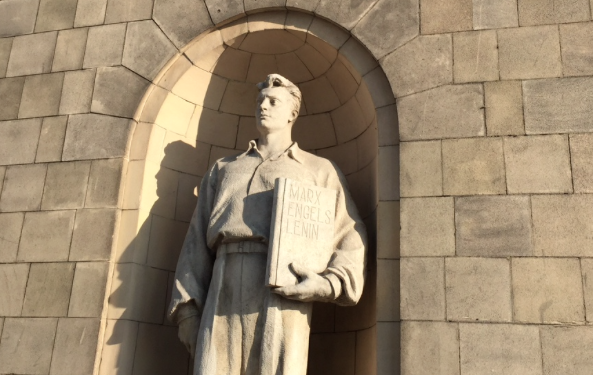
On the other side of the building, was the last statue of the communist period left standing. A young man, holding a tablet with the names of Marx, Engels and Lenin looks into the distance. The modern buildings juxtaposed, are what he now looks at. Stalin’s name was on the tablet, but was removed after the break in 1989. Also interesting is the name of the nightclub that is in the building, sitting just above this symbol of anti bourgeoisie!
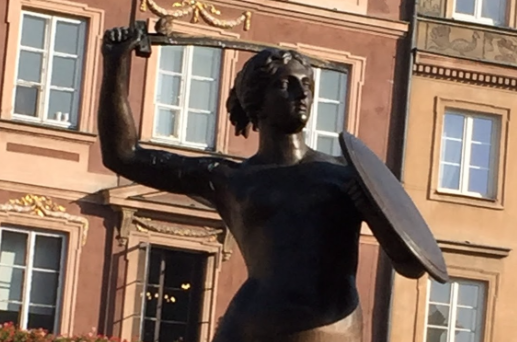
We walked to the “old town” where we saw a statue of King Sigzman the III, who moved the capital of Poland from Krakow to Warsaw in the 16th century, we also saw where the original walls of the castle fortress that housed Polish kings; who were elected to the position rather than inherited from 1570 onward.
95% of the “old city” of Warsaw was destroyed during the war. Everything, all of the buildings, were reconstructed in their original appearance, so that the facades shown, were all constructed. In the midst of the square is a statue of a mermaid with a sword and a shield. This evolved from a warrior woman astride a bear over the years, but is a symbol of Warsaw. So too, is the Phoenix, the mythical bird that rose from the ashes… As the city of Warsaw rose from being almost completely destroyed to the bustling capital it is today.

Finally, we went to the memorial of the Warsaw uprising in 1944. Not to be confused with the Ghetto uprising in 1943, this was an effort of the people of Warsaw to take back their city from German occupation. It failed. 200,000 people lost their lives, 150,000 were civilians. There were memorials all over the grounds as “All Saints Day” was just 2 days ago. A quarter of the city was destroyed initially, then German bombing ended the uprising after 68 days and most of the rest of the city was destroyed.
-Written by Marcie
Monday, Nov 2, 2015
Our first night!
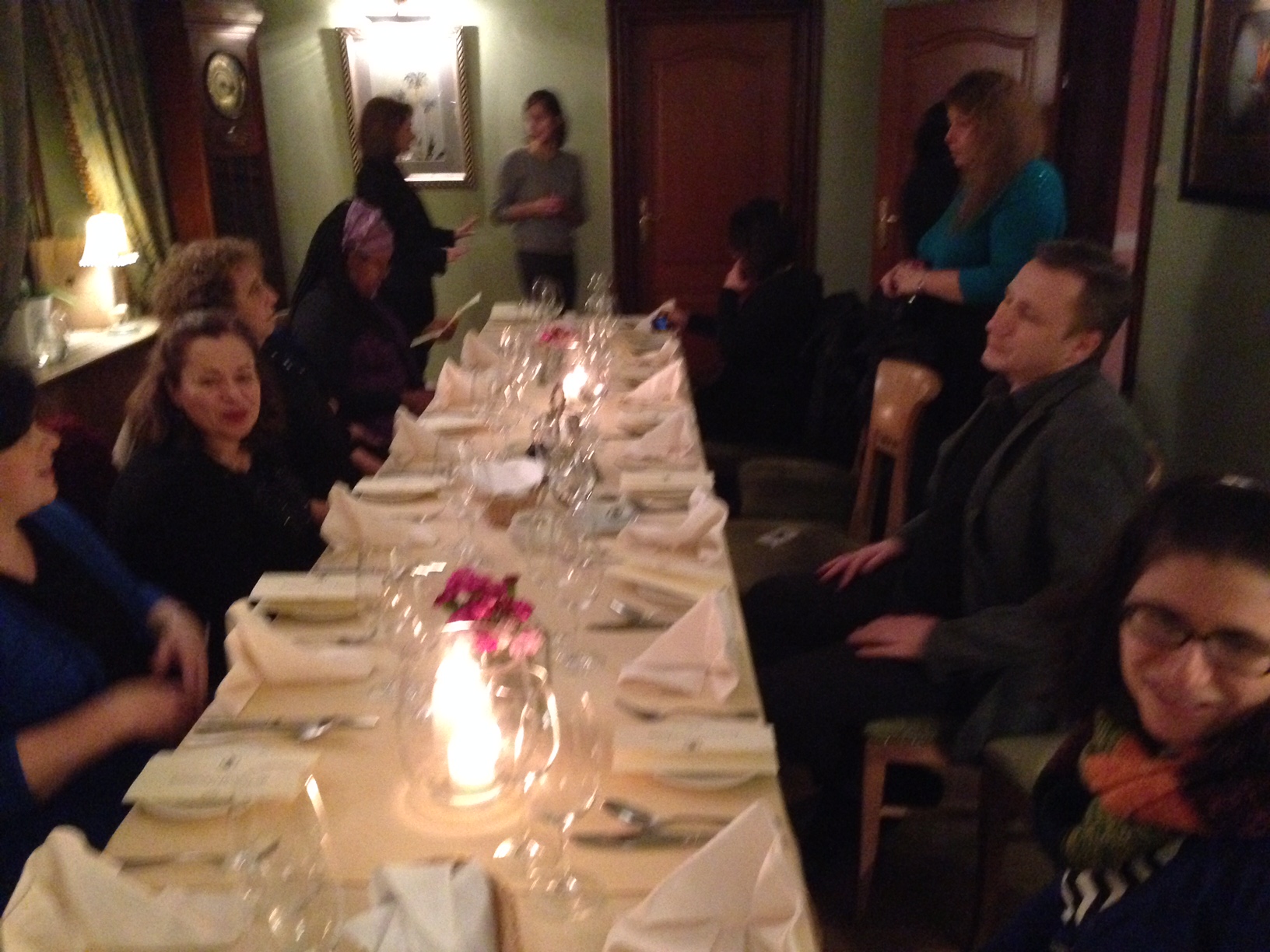 We went to dinner at Dom Polski, a fantastic restaurant, with our hosts from Forum for Dialogue (Andrzej and Olga). The night was amazing, with great good and a fantastic, mind blowing conversation.
We went to dinner at Dom Polski, a fantastic restaurant, with our hosts from Forum for Dialogue (Andrzej and Olga). The night was amazing, with great good and a fantastic, mind blowing conversation.
The conversation at the dinner table touched the surface of our purpose here: how do we change a dismissive mindset at home and abroad to increase awareness and consideration about the Holocaust. We shared our personal stories and Andrzej opened up about why he felt it is his life’s mission to improve relations between Jews and Poles. It is amazing how much work needs to be done, even after all this time.
-Written by Noah
Monday, Nov. 2, 2015
We Arrived!
Today was a day of buses and airplanes. If I have the totals right, we rode 8 buses and 3 airplanes to get here. It was a long day of travelling, but the time gave us lots of time to get to know one another and to bond as a group.
Waiting for our (delayed) flight at the Berlin airport.
Riding one of the many shuttle buses. Hang on tight!
On the plane on the way to Warsaw.
On still another bus in Warsaw.
We are staying at the Marriott in Warsaw. It is a beautiful hotel. This is the view from my hotel room on the 24th floor.
We had a few hours of free time this afternoon before dinner. Some people went for a swim, some decided to rest, and others walked around exploring the area.
Outside a shopping mall.
Warsaw has more cheese than Wisconsin! There were more 4 cases of different types of cheese!
Tonight we will have an opening dinner with the leaders of our trip. Keep reading our blog. Post messages for us on Facebook and Twitter!
– Written by Tzipi
Sunday, November 1, 2015
Off to Poland we go! Stay tuned for the post of our first day in Poland!
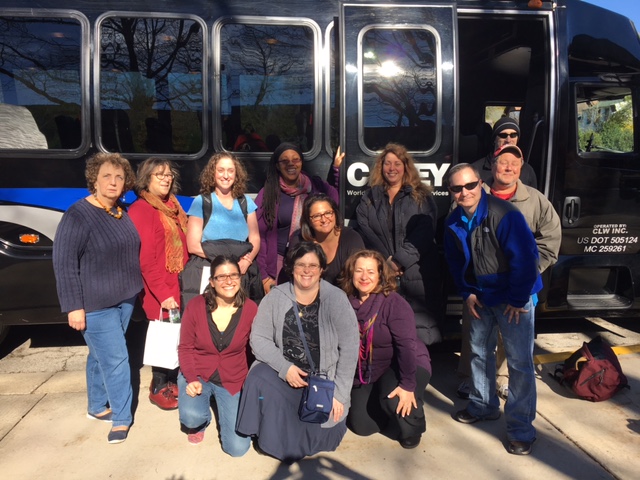
Wednesday, October 28, 2015
Read trip participant Phil Musickant’s thoughts as he prepares for the Milwaukee Jewish Educators’ Trip to Poland. This article was published in Congregation Emanu-El of Waukesha’s newsletter.
Monday, October 26, 2015
Let us introduce you the Milwaukee educators who will be participating in the Milwaukee Jewish Educators’ Trip To Poland!
Tziporah Altaman-Shafer Noah Kaufman Rabbi Marcey Rosenbaum Laurie Herman
Sara Minash Karen Torem Jennifer Saber Ellie Gettinger
Rabbi Tiferet Berenbaum Aggie Goldenholz Phil Musickant Aaron Bergtrom
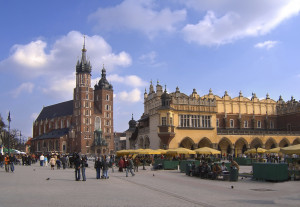
Krakow, Poland
Monday, October 12, 2015
November 1-8, a group of Jewish Educators from all over the Milwaukee Jewish Community will travel to Poland through the program Forum for Dialogue. The thirteen educators will visit important sites related to the Shoah, but they will also dialogue with students and teachers in Poland about life before WWII and about current relations between Jews and Poles. We will be blogging about the trip every day except Shabbat. Please follow our learning adventure. Feel free to leave us comments and messages.
The teachers participating in the trip are: Tzipi Altman-Shafer (me), Rabbi Tiferet Berenbaum, Aaron Bergtrom, Ellie Gettinger, Aggie Goldenholz, Laurie Herman, Noah Kaufman, Sara Minash, Phil Musickant, Rabbi Marcey Rosenbaum, Susie Rosengarten, Jen Saber, and Karen Torem.
Teachers represent the following organizations: Camp Interlaken, Coalition for Jewish Learning, Congregation Beth Israel Ner Tamid, Congregation Emanu-El B’ne Jeshurun, Congregation Emanu-El of Waukesha, Congregation Shalom, Congregation Shir Hadash, Congregation Sinai, Jewish Museum Milwaukee, Milwaukee Jewish Day School, and Yeshiva Elementary School.
More trip updates coming soon!
Tziporah Altman-Shafer
Jewish Education Community Planner



